Gear-obsessed editors choose every product we review. We may earn commission if you buy from a link. How we test gear.
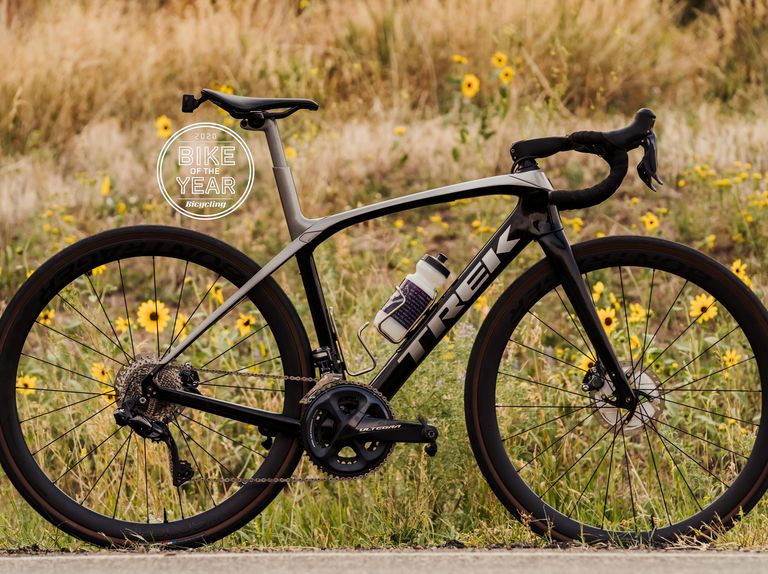

Trek’s Best Road Bike Ever Is the Third-Generation Domane SLR
Smooth, fast, and smart: The new Domane is everything a modern road bike should be.
The Takeaway: Higher performance, more features, more versatile: The third generation Domane is one of the best road bikes you can buy right now.
- Clearance for up to 38mm tires
- Internal storage system
- Improved aerodynamics save 12 watts
- 27 percent more compliant than the previous model
Price: $7,800 Weight: 18.9 lb. (54cm)
The third generation of Trek’s Domane is not just the best Domane, it is Trek’s best-ever road bike. And one of the best road bikes on the market right now.
Few bikes offer what the Domane SLR does: a bike that’s equal parts performance, comfort, practicality, and versatility. It’s more aerodynamic than the outgoing Domane (saving 12 watts at 4oKph) and takes at least a 38mm tire, and it has hidden fender mounts and sleek internal storage.
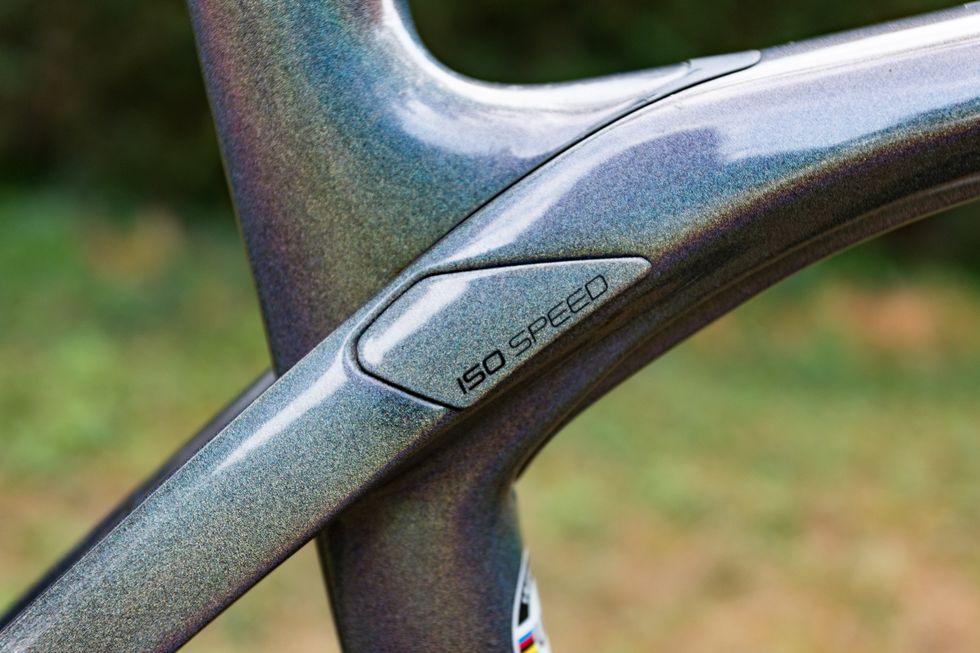
It has compliance-enhancing decouplers front and rear that work very well to improve both rider comfort and control, and that don’t detract from the bike’s pedaling efficiency or handling. The steering is light, and its handling precise, but with a mellower edge and more stability than a road-racing bike. That helps make it one of the best bikes on which to descend roads, as well as a capable all-road and light-gravel bike.
Style Road, All Road Material Carbon Tire clearance 38mm Drivetrain Shimano Ultegra Di2 Chainrings 34/50 Cassette 11-32 Brakes Shimano Ultegra Hydraulic Disc Wheels Bontrager Aeolus Pro 3v, tubeless ready, 25mm internal width Tires Bontrager 32 Hard-Case Lite, 32mm Handlebar Bontrager Pro IsoCore VR-CF Stem Bontrager Pro Saddle Bontrager Arvada
It is what a modern road bike should be: fast, crisp, useful, adaptable, and rider-friendly. The 32mm tires come stock on all but one model, a decision I couldn’t applaud more. Fat tires rule because they’re less prone to flats, can go more places, and don’t require you to dodge every groove and hole in the road. Not only do they ride smoother, Trek says its testing indicates they’re faster at speeds under 20mph (over 20 and the aero penalty takes over).
It is a touch heavy—it gains about 100 grams compared to the outgoing version—though it doesn’t ride that way. And it’s such a good and well-done bike, the extra weight seems worth it.
Trek Domane SLR 7
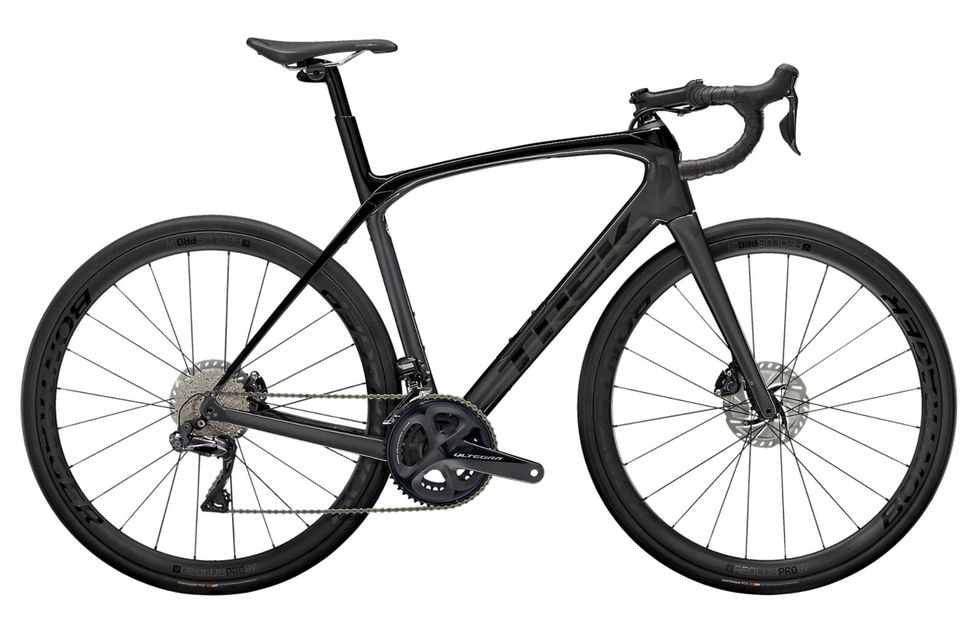
But if you’re a gram counter, know that the long-term review bike—a $7,800 Domane SLR 7 with Ultegra Di2 Carbon wheels and carbon handlebar—weighed just a touch under 19 pounds. That means the lower-end bikes will weigh even more. This new third-generation bike comes in 10 models priced from $2,300 to over $11k, plus the option to customize build and finish in Trek’s Project One program.
This is the bike most of us should ride. It’s entertainingly sharp and sporty, smooth, smart, and versatile enough for most forms of road riding—paved or gravel. And that’s why it’s one of the best bikes you can buy right now and why we chose it as the best bike of 2020.
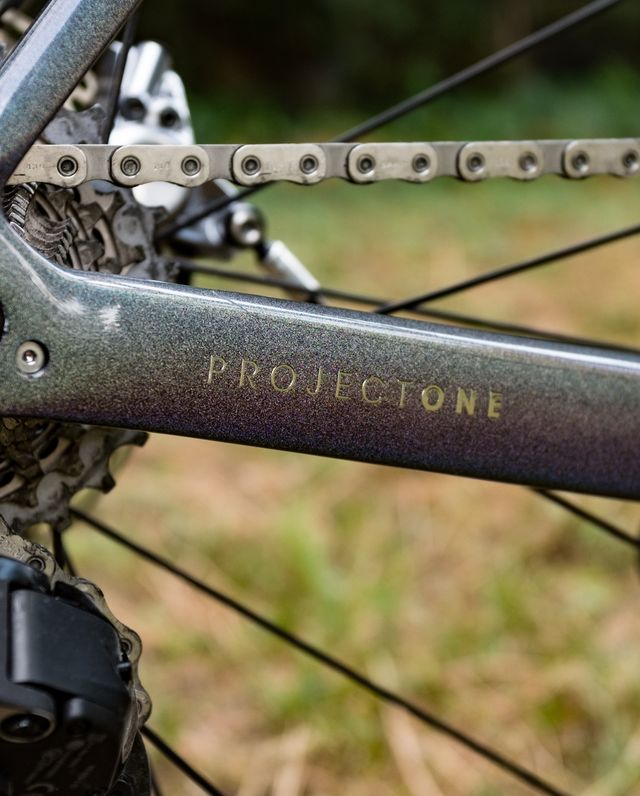
Custom Options
There are 10 stock Domane models, but you can also customize in Trek’s Project One.

Big Clearance
The Domane officially fits 38mm tires. Unofficially, you can squeeze in 40s.
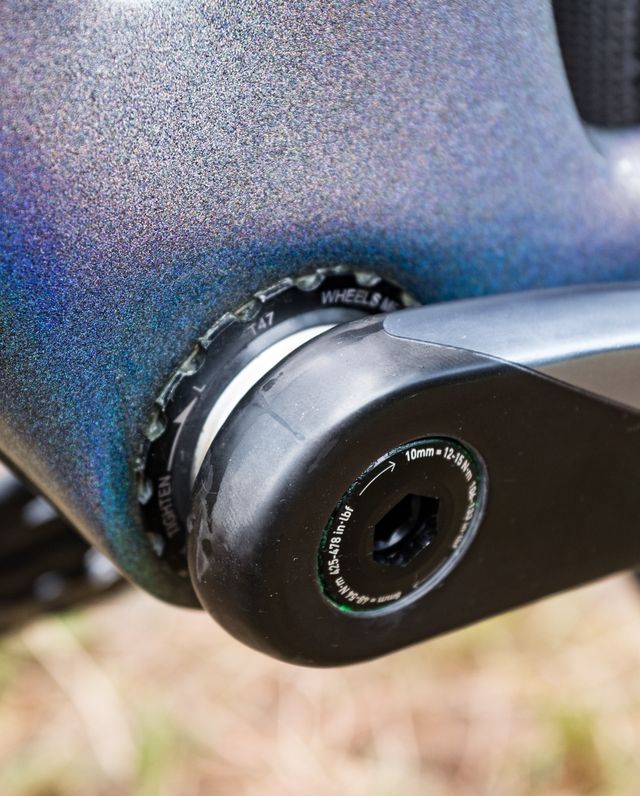
Now With Threads
The Domane uses a threaded T47 bottom bracket.
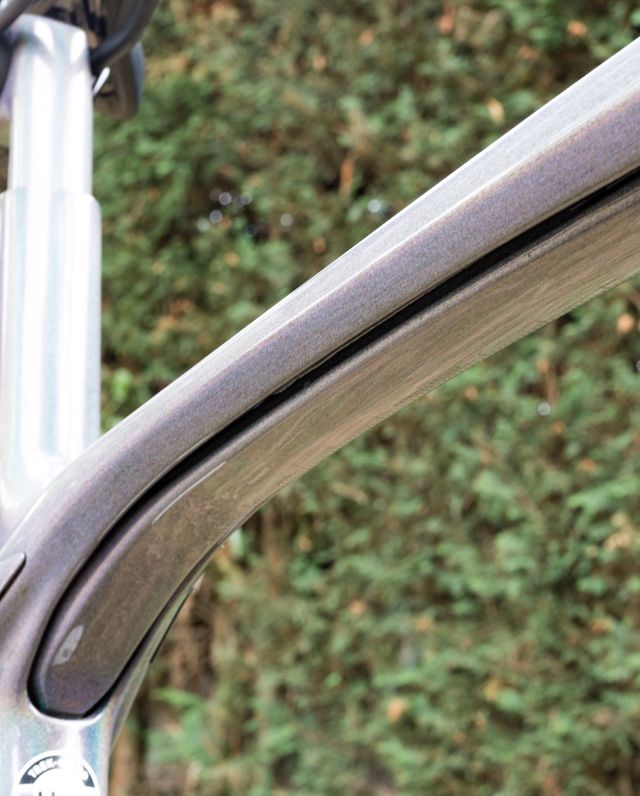
Flexy Tongue
The compliance of the rear IsoSpeed system is adjustable.
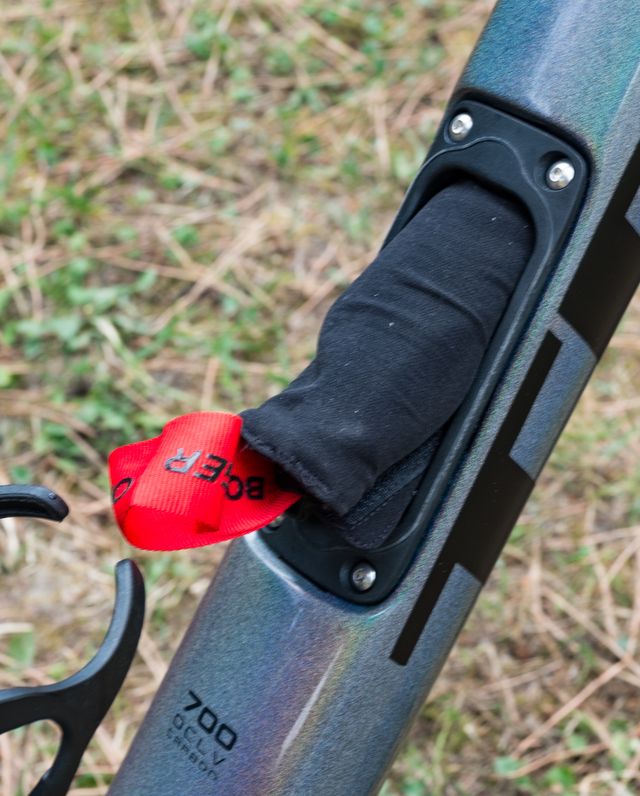
Burrito Carrier
Fit a repair kit and more inside the Domane’s down tube.
The 2020 Domane is the third generation of Trek’s venerable endurance—and race—frame. Jordan Roessingh, Trek’s global director or road product calls it “Our most versatile performance road bike ever,” which is the kind of thing you’d expect a person in his position to say. But it’s hard to argue with him when you look over the Domane’s details.
This system is up to 27 percent more compliant than the one found on the second-generation Domane, with a rubber elastomer providing damping to tame unwanted bounce. Compliance is pegged to frame size—larger bikes get stiffer IsoSpeed tongues, smaller bikes have softer tongues. Lower-grade Domane SL models continue to use the seat-tube adjustable IsoSpeed system from generation-two Domane models. This system does not have the size-specific tune or the damper.
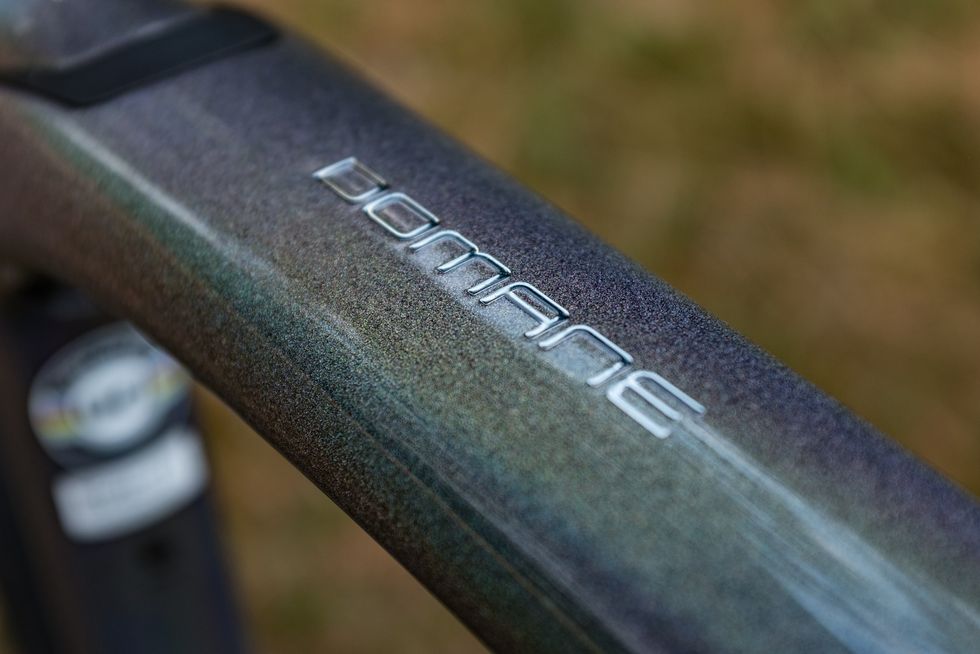
The new Domane still uses Trek’s modified seatmast system—though the cap now fits inside the seat tube instead of over—with an internal binder for a sleeker look. The mast top comes in several lengths and two offsets.
Join Bicycling All Access for in-depth bike reviews
Most gen-three Domane models ship with 32mm tires. Bigger tires are more comfortable and offer better grip. And for most recreational riders, Roessingh says the 32mm tires are faster. According to Trek’s testing, says Roessingh, at speeds under 20mph, a 32mm is faster because it has less rolling resistance than a narrower tire. However, when speeds creep over 20mph, the aerodynamic hit of the bigger tire becomes a factor and begins to swamp the rolling resistance advantage of a wider tire.
The Domane can fit up to a 38mm tire with 4mm of clearance on all sides. That means you can shoehorn in a bigger tire—perhaps up to 40mm—though with less debris clearance. Like earlier versions, the new Domane has hidden fender mounts; with fenders, up to 35mm tires may be fitted.
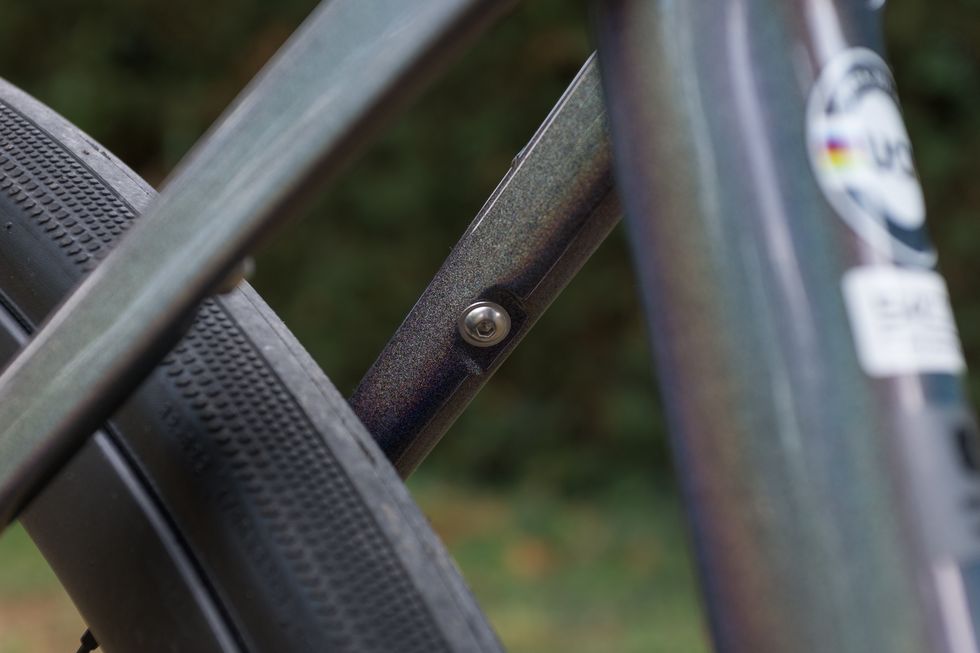
Trek’s engineering elves managed to add a bit of free speed to the Domane by adding some aerodynamic features. Compared to the previous-generation frame, and with the same build, the new Domane saves about 12 watts at 40Kph (good for about one minute of time savings per hour). The aero gains are due to refined tube shapes, as well as new hose and housing routing.
The hose and housing routing is smart. The Domane’s front IsoSpeed system prevents Trek from stuffing hoses and housing along the fork steerer, a solution many other bikes employ. On the Domane, they enter the frame behind the headset, directed there by a simple hoop that clips into the faceplate of the bike’s Bontrager stem. The Domane is compatible with any bar and any stem, though only Bontrager stems work with the hose and housing hoop.
The Domane is the first bike to launch with Trek’s new internal storage system. It’s the same concept as Specialized’s SWAT box : Remove the panel under the bottle cage to access the inside of the down tube. Included with the bike is a cloth-covered organizer roll with spots for a tube, tire lever, Co2 cartridge, and inflator head. You can fit the organizer roll and a bit more—a few bars or gels, for example—though the amount of space varies with frame size. You can expect to see this system on more Trek models in the future.
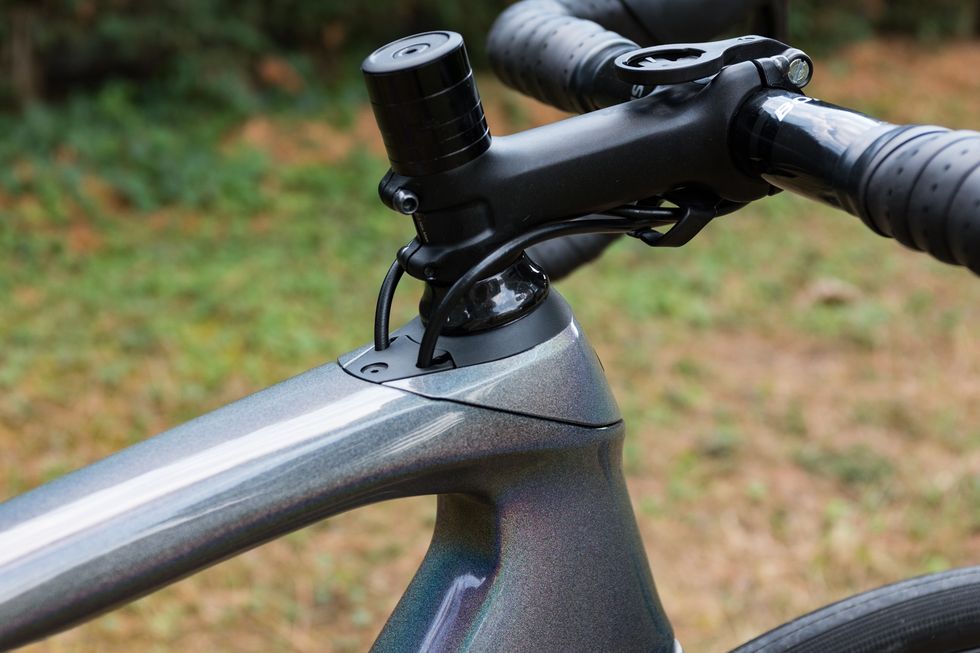
Another new feature is a modified T47 bottom bracket system. Trek narrowed the width of the Domane’s BB shell by one millimeter (compared to the T47’s written standard) then added thicker flanges (a half millimeter on either side) to the BB itself. This gives the T47’s installation tool more material to bite on. Frankly, it’s a good modification: The standard T47 BB’s have very thin flanges and it’s easy to slip a tool when trying to install or remove one of the bottom brackets. Trek’s modification does not affect the system’s compatibility with cranks or bottom brackets.
Though an all-new frame in most ways, mainline Domane models carry forward the same endurance geometry. Through Trek’s Project One customization program, you can order a lower stack and longer-reach geometry that Trek calls H1.5.
The Domane Family
The new Domane line consists of 10 stock models priced from $2,400 to $11,299. All models have carbon frames and use disc brakes. If the stock builds don’t suit your needs, the new Domane is also in Trek’s Project One customizable-build-and-paint program. You can also purchase Domane frameset for $3,300.

There are two frame levels: SL with Trek’s 500-series carbon and SLR with 700-series carbon. SLR models get all the new features and are lighter. Lower-grade Domane SL models continue to use the seat-tube-adjustable IsoSpeed system from second-generation Domane models: This system does not have the size-specific tune or the damper.
Only SLR models get Bontrager’s IsoCore carbon bar which features a layer of vibration-damping material in the carbon. However, all models get IsoZone gel pads under the bar tape.
Following a growing trend, Trek did away with women’s-specific geometry and model designations in the new Domane line. Instead, the company added more sizes, more builds, and more color options to its mainline Domane models. So while Trek’s Domane WSD models go away, representatives argue that all riders get more options than before.
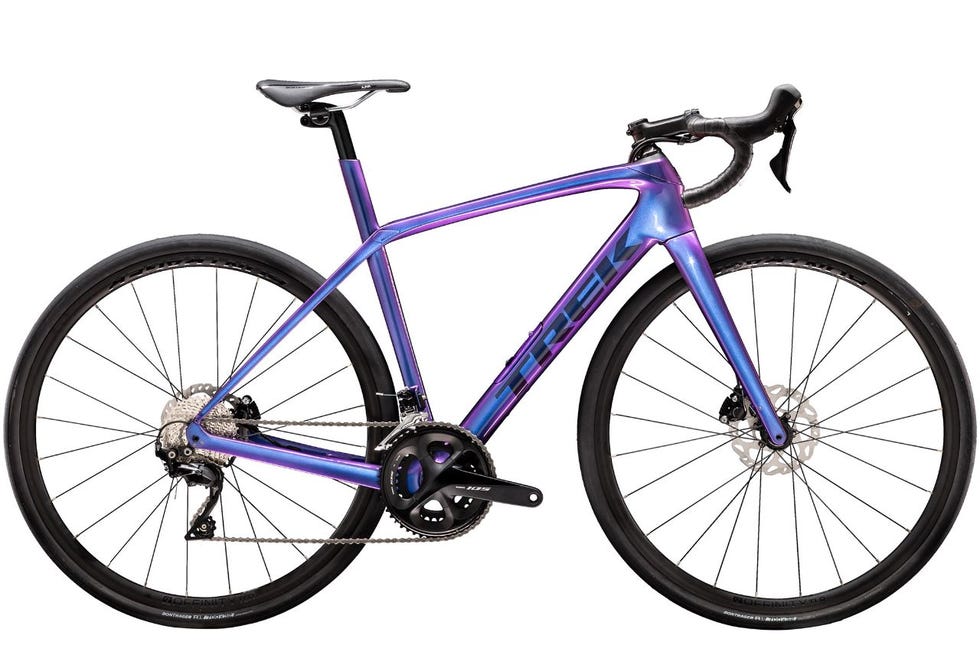
Some of the build adjustments from its women’s-specific models—shorter-reach and narrower bars, shorter stems, and shorter-reach brake levers—were incorporated into smaller sizes. The only thing not found in this new scheme are models that come stock with a women’s saddle. Buyers will need to work with their Trek retailer to get a saddle that suits their anatomy. I hope Trek retailers will swap for an equal-level Bontrager saddle at no charge.
Ride Impressions
I attended the Domane launch in Italy, where I had the opportunity to ride only a customized version of the Domane. Though it is possible to build the bike I rode through Project One (the price of the bike I rode would be approximately $11,600), it was not a mainline model with a stock build.
The day after Trek launched the new Domane, I received a Domane SLR 7 ($7,800 with black/silver finish) for long-term review. This model has Shimano Ultegra Di2 drivetrain (34/50 rings with 11-34 cassette) and brakes, Bontrager’s Aeolus Pro 3V tubeless-ready wheels, 32mm Bontrager R3 Hard-Case Lite tires, and a Bontrager IsoCore carbon bar.
On my scale, the Domane SLR 7 weighed 18.9 pounds (54cm). That’s not light for a nearly $8,000 carbon road bike in 2019. For comparison, my Cannondale SuperSix Evo Hi-Mod Disc Ultegra Di2 ($7,750) review bike weighs 17.1 pounds (54cm) with similar build, and a power meter. The Domane SLR 9 with the 28mm tires, higher-end wheels, and top-of-the-line drivetrain will be lighter than my review bike. But almost all other 2020 Domane models will likely weigh about 19 pounds or more.
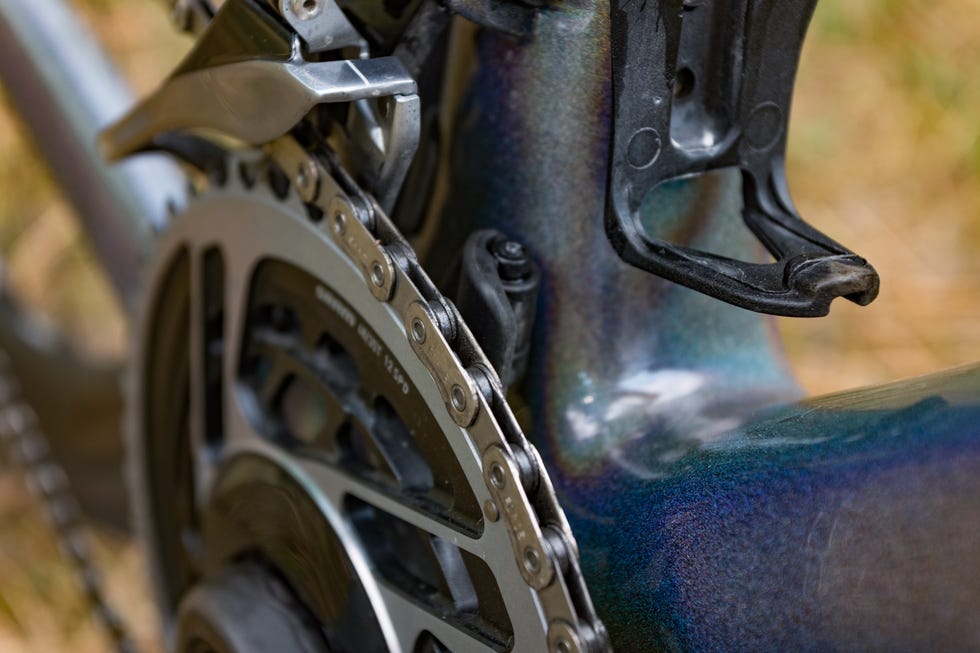
The Domane has a lot of stuff going on; it’s the most feature-rich performance road bike you can buy right now. But adding stuff adds weight. Adding performance—aerodynamics, and compliance—can add weight. “The new [Domane] SLR and SL frames both gained about 100g when all the frame and hardware (IsoSpeed included) are rolled up,” said Roessingh.
But given how obsessive cyclists are about weight—despite constant reminders that weight isn’t a major influence on performance in most situations—if a brand is going to add weight, it better damn well pay off.
Based on my impressions of the Domane so far—ride and otherwise—it does. The weight is not a concern. Most important, it doesn’t ride heavy. The bike is quick and fast feeling; extremely stiff at the bottom bracket, with light and precise steering. On the steepest grades, yeah… it’s not as crisp and ethereal as a 13-pound climbing bike , but then it doesn’t feel like a 19-pound bike either. Before I knew its weight, I had it in my head that it weighed around 17.5 pounds—a typical weight for a bike with an Ultegra Di2 disc group.
But more significantly, the amount of time I spend on the type of grades where its weight might be noticeable or impactful is tiny. I suspect it’s the same for most riders who aren’t in the pro peloton.
And what you get for a bit of extra weight is Trek’s best road bike, and one of the best road, and more, bikes you can buy.
This is a stiff, quick, and high-performance bike. The steering is light and communicative, though not as fast as the typical road-racing bike. But the Domane also has a lot of BB drop (about 78mm, almost a centimeter more than a typical road bike), a bit longer chainstays (420mm), and a slightly stretched wheelbase. All of that gives it supreme stability.

On top of the geometry are the IsoSpeed decouplers, which not only add comfort to the rider but also help the rider stay centered on the bike and not bounced off line by bumps. And then there are the floaty and sticky 32mm tires. Friends, the Domane has been a great bike to descend with, but this new model puts it on a whole new plain. It descends like an anvil dropped from the ISS.
As much as I love to go downhill, I’m only a good, not great, descender on the road. But I’ve never felt more confident on the descents or had as much fun descending as I have on the Domane. Its limits are very high, but it’s also very communicative and very confidence-inspiring.
So, it rides great. But it’s also extremely smart and versatile.
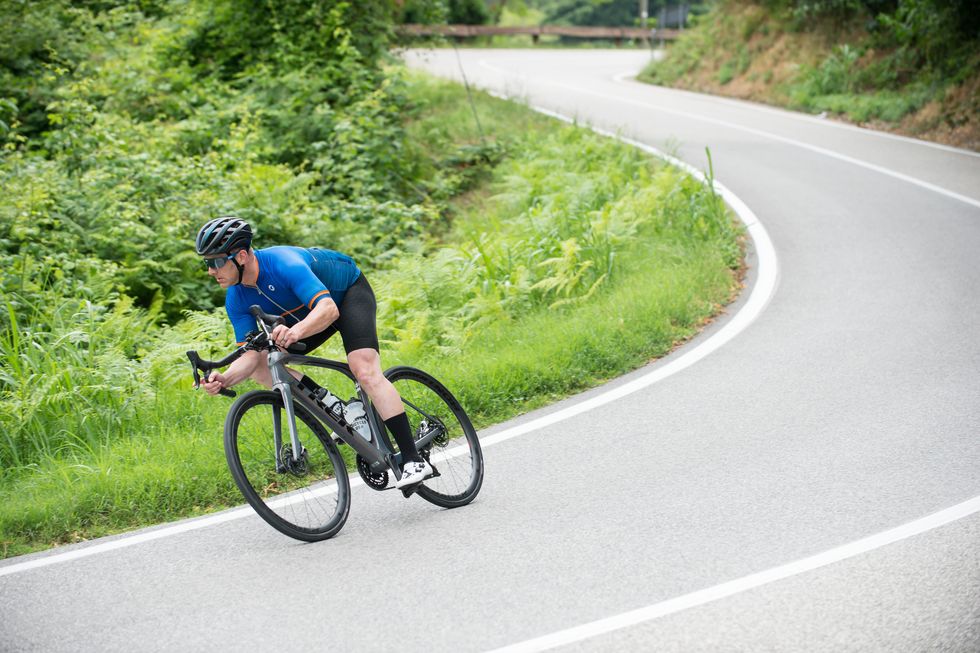
I loved the SWAT box when Specialized launched it, and I love it here. It’s more, and more elegant, storage for your tools and spares and food. However, I have some worries about the integrity of the door. With a full bottle in the cage, there’s a concerning amount of flex and wobble in the door (Specialized’s doors are rock solid). I wonder how this will play out with tolerance drifts, and over the long haul. How will it hold up after a year of pounding? Time will tell, I suppose. And as much as it wobbled and flexed, it held firm and makes no noise. Trek’s representatives say they’ve tested the snot out of the system and its passed with flying colors. I hope it proves so reliable in the real world.
I also love the tire clearance. Swap the tires, and this is a good all-road or even gravel bike. Frankly, I think a lot of gravel bikes are over heavy and over slow. But a good set of mid-width gravel tires on this Domane and it’s a cracking machine for all but the most gnarly gravel roads. Put lighter skinnier tires on it, and it’s going to be a fast road bike (watch those pedals in the corners—the BB is LOW with smaller tires). I love that blend of road-race performance with all-road versatility.

I also love that the new Domane has aero touches (because improved aerodynamics are one of the few things that legitimately make you faster), that it doesn’t use a stupid or annoying proprietary bar and stem system, has fender mounts, and that Trek was able to give this bike so many features, and they made it look good.
Yes, it is a bit less sharp than a pure road-racing bike, and it might be a bit heavy, but then so am I. The Domane is a blend of versatility, practicality, and performance that no other bike currently offers. It’s the kind of bike we could all use in our life.

A gear editor for his entire career, Matt’s journey to becoming a leading cycling tech journalist started in 1995, and he’s been at it ever since; likely riding more cycling equipment than anyone on the planet along the way. Previous to his time with Bicycling , Matt worked in bike shops as a service manager, mechanic, and sales person. Based in Durango, Colorado, he enjoys riding and testing any and all kinds of bikes, so you’re just as likely to see him on a road bike dressed in Lycra at a Tuesday night worlds ride as you are to find him dressed in a full face helmet and pads riding a bike park on an enduro bike. He doesn’t race often, but he’s game for anything; having entered road races, criteriums, trials competitions, dual slalom, downhill races, enduros, stage races, short track, time trials, and gran fondos. Next up on his to-do list: a multi day bikepacking trip, and an e-bike race.

.css-1t6om3g:before{width:1.75rem;height:1.75rem;margin:0 0.625rem -0.125rem 0;content:'';display:inline-block;-webkit-background-size:1.25rem;background-size:1.25rem;background-color:#F8D811;color:#000;background-repeat:no-repeat;-webkit-background-position:center;background-position:center;}.loaded .css-1t6om3g:before{background-image:url(/_assets/design-tokens/bicycling/static/images/chevron-design-element.c42d609.svg);} Bike Reviews
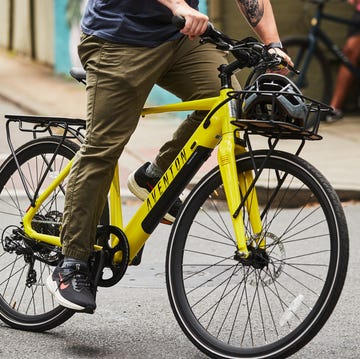
Reviewed: BMC's Fourstroke LT

New Specialized Chisel Full Suspension Reviewed

Little Bike, Big Attitude: Scor’s 2030

The Best Commuter Bikes for Getting Around Town

The 13 Best Electric Bikes, Tested by Our Editors
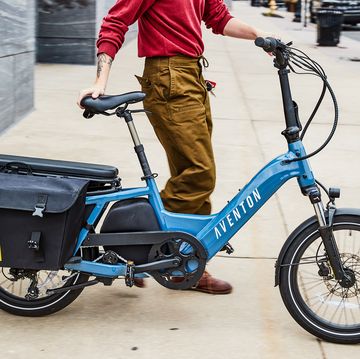
The Best Folding Electric Bikes

The 10 Best Mountain Bikes You Can Buy Right Now
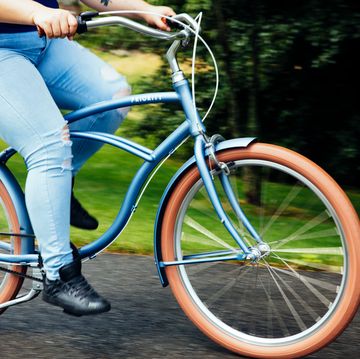
The Best Beach Cruisers for Leisurely Rides

The Best Hardtail Mountain Bikes

Best Hybrid Bikes You Can Buy Right Now

The 14 Best Road Bikes of 2024

Domane SLR 7 Review
A quick, high-performance ride is possible with the Domane SLR 7, an ultralight endurance road bike with premium components. You receive OCLV Carbon wheels, an entirely new wireless electronic Shimano Ultegra Di2 drivetrain for precise shifting, an OCLV Carbon frame with Front and Adjustable Rear IsoSpeed, and streamlined internal storage. It also offers a convenient storage space where you can store your essentials for the voyage.
Specification
pros & cons, check specifications here.
If you want the lightest, fastest road bike we make and have great goals for road racing, the Emonda SLR 9 Disc eTap is ideal for you. A smooth, accurate SRAM RED eTap AXS wireless electronic drivetrain and the best carbon wheels from Trek are also essential.
A 700 gram or less, ultra-aerodynamic 800 Series OCLV Carbon frame, a 2×12 SRAM RED eTap AXS wireless electronic drivetrain, ultra-lightweight, quick, and stable Bontrager Aeolus RSL 37 OCLV Carbon wheels, an integrated aero bar/stem from Aeolus RSL OCLV Carbon, an SRAM RED AXS power meter, and strong hydraulic disc brakes.
Ultralight OCLV Carbon Frame
Trek uses their ‘800 series OCLV carbon lay-up’ for the frame.
Innovative technologies are used in Trek’s 800 series OCLV carbon to enhance the material’s physical and aerodynamic properties. On the Trek Emonda SLR 9 eTap, they use this specially constructed composite. Trek asserts that it uses a very high-quality carbon-resin composite since aerodynamic tube forms are heavier and less rigid than standard, spherical tubes. This results in a weight reduction of little under 10% when compared to an OCLV 700 frame, with the SLR frame constructed from OCLV 800 weighing only 698 g. The material is lighter the higher the number after the OCLV.
Less material is needed to provide the same riding capabilities thanks to the new material’s remarkable 30 percent improvement in strength over prior OCLV Carbon while maintaining the same stiffness.
Groupset, Chainrings, Cassette
With 48/35 t chainrings and a 10-33 t cassette, Trek specifies an SRAM RED eTap AXS groupset. This bike offers the largest gear range in the group test, along with the Specialized S-Works Tarmac SL7, providing enough reserves for less ambitious riders and really challenging climbs. The BMC Teammachine SLR01 ONE with its 10-28 t cassette has slightly smaller gear spacing, though. You can always monitor your performance and keep everything under control with the factory-installed dual-sided power meter. The Emonda is incredibly well-equipped for the challenging descents that frequently follow challenging climbs because of the strong and simple to modulate SRAM AXS HRD brakes with 160 mm discs at the front and rear.
Geometry and Comfort
A few adjustments have been made to Emonda to increase ride comfort. In terms of shape, it receives a Goldilocks makeover. There is a geometry called H1.5 that is between the constrained H2 endurance geometry and the aggressive H1 geometry. Even though it is plainly more aerodynamic, we could easily bike for hours in this position. The next comfort element for the Emonda is the adjustable top tube IsoSpeed, a design idea that was first used for the Domane spring classics race bike.
Hydraulic Disc Brakes
With the head tube flaps, specially created integrated brakes are connected to disc brakes.
Still available from Trek is the Emonda SLR 9 eTap with rim brakes. The majority of its rivals have upgraded to disc brakes for their most recent aero bikes, making it one of the few businesses left that still sells rim brakes.
While I had the bike, the hydraulic disc brakes required no maintenance and were easy to use. The lever feel is perfect for smoothly delivering the power in any situation, and there is enough of it.
One advantage of disc brakes is increased tyre clearance, which accommodates 28mm tyres. That is a wise decision if you want to increase comfort. Tyres up to 25mm in diameter can be used with Emonda SLR 9 eTap rim brakes.
Color Choices
For Men & Women:
Emonda SLR 9 eTap is available in Six colors—Navy Carbon Smoke/Viper Red, Navy Carbon Smoke/Blue, Matte Onyx Carbon, Dark Prismatic/Trek Black, Amethyst, Radioactive Coral to Yellow Fade. Also variety of Eight sizes (47, 50, 52, 54, 56, 58, 60, 62). It weighs roughly just (size 56) 6.75 kg / 14.89 lbs. Emonda SLR 9 eTap bike has a maximum total weight limit (combined weight of bicycle, rider, and cargo) of 275 pounds (125 kg).
Oh! What a feeling
Aerodynamic, lighter than 700g, and a dream to ride is Trek’s quickest climbing frame. The most intelligent, smoothest wireless electronic shifting currently available is SRAM RED eTap AXS. The lightest laminate Trek has ever produced is the 800 Series OCLV Carbon. The Aeolus RSL 37 climbing wheels were created in collaboration with Emonda. Make it yours: Project One allows for complete customization.
Specifications
Check specifications here
Pros & Cons
Excellent in handling, made for racing
Amazing disc brakes, performance positive ride, great wheels, feels very lightweight, some might found issue with tire clearance, rattling sram shift levers, what is difference between trek domane sl and slr.
The SL’s frame is significantly heavier than the SLR’s and is made of OCLV 500 composite. The frame of the SL weighs 1,142 grams, while the fork is 380 grams (SLR fork weight: 365 grams). But the only distinction between the SL and SLR is one of material (and weight).
What does trek Domane SLR 7 weigh?
Domane SLR 7 weighs around (size 56) – 8.40 kg / 18.52 lbs (with TLR sealant, no tubes).
This bike has a maximum total weight limit (combined weight of bicycle, rider, and cargo) of 275 pounds (125 kg).
Which size do I get for Domane SLR 7?
The charts below illustrate our suggested sizes based on height, but other elements, such as arm and leg length, can affect how well something fits. You’ll see some overlap in our suggestions as a result. For example, not every rider who is 5’8″ will fit on the same size bike. Consult the specialists at your neighborhood retailer for the greatest advice on finding your ideal fit.
Is trek Domane SLR 7 a comfortable bike?
Yes, this is the essence of the Domane SLR 7 or even full Domane family. Thanks to the front and rear IsoSpeed and the possibility to mount tyres up to 38mm wide, it feels quite comfortable. Your neck and back are also relieved of stress by the relaxed geometry.
Where can I get the Domane SLR 7?
Trek Domane SLR 7 can be purchased direclty at Trek .
Total score
Our rating.
Trek’s top-tier Domane carbon frame features wireless Shimano Di2 for its precise shifting. During long races and competitive group rides, you’re getting technology that offers a genuine advantage in comfort, dependability, and speed.
Trek’s Endurance road bike is called the Domane. It is designed for excruciatingly long and difficult rides. Trek’s IsoSpeed technology, which functions as suspension for your rigid frame road bike, is a feature of the 2022 Domane SLR 7.
Check latest price of TREK Domane SLR 7
Similar products being reviewed.

Bicycle Helmets 101: The Ultimate Buyer’s Guide


Where can you get a bicycle? Consumer Direct…
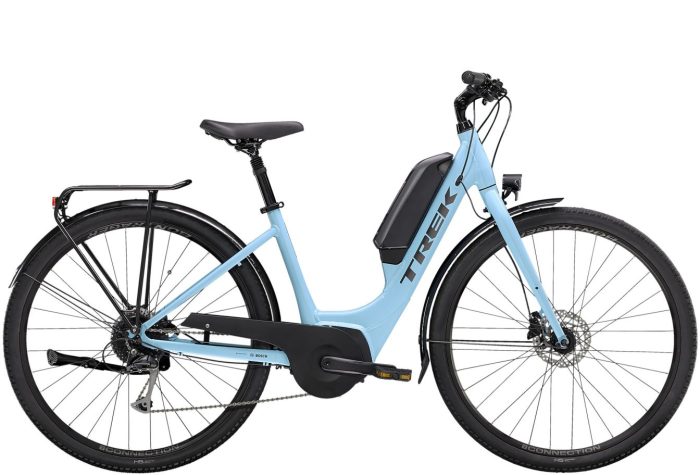
TREK Verve+ 2 Lowstep Review
If you have any suggestions or advise, please feel free to reach us via our Contact Us here.
Powered by Outside
The 2023 Trek Domane is now official: SL, SLR, and RSL options explained
The endurance road bike returns to its endurance road purpose..
Heading out the door? Read this article on the new Outside+ app available now on iOS devices for members! >","name":"in-content-cta","type":"link"}}'>Download the app .
Trek hasn’t exactly been shy about the fact a new Domane was imminent. We saw the endurance-come-all-road bike earlier in the year at the Classics, and Elisa Longo Borghini even rode it to victory at Paris-Roubaix Femmes.
Now Trek has lifted the translucent curtain from the new bike, revealing all the finer details and model options. We have the new Domane SLR in hand for review but we need a little more time on it before we can offer an informed opinion. In the meantime, here’s what we know about the newly updated endurance road platform that consists of the Domane SL, the top-tier Domane SLR, and the return of a pro-friendly Domane RSL.
Simpler = lighter
In many ways, the new Domane returns to the roots of the endurance road platform. When it was first released a little over a decade ago, the Domane was a fully-fledged road bike, just with added ride comfort and more relaxed geometry. A subtly modified version was Fabian Cancellara’s pick for conquering the cobbles, and Trek surely sold a lot of bikes off that imagery.
However, more recent years have seen the Domane get increasingly more complicated, and that complexity came with added mass. For example, Trek took its original IsoSpeed concept from a simple flexible seat tube decoupled at the top tube via a bearing-based pivot and turned it into a system (at least at the high-end) that split the seat tube around a sliding mechanism that allowed you to tune the seated comfort. Meanwhile, the once ordinary front-end of the bike earned a de-coupled headset that allowed the fork steerer to flex more freely.
All impressive features, but also things that made the Domane heavier than a bike of its price should be.
And so we come to the newest version of the Domane. This bike waves goodbye to both the adjustable rear IsoSpeed and front IsoSpeed and instead moves to Trek’s fourth iteration of the comfort-inducing feature. Similar to the original introduced in 2012, this new and rear-only IsoSpeed isn’t adjustable and the only moving components are isolated to the pivot point that sits between the seat tube and top tube.
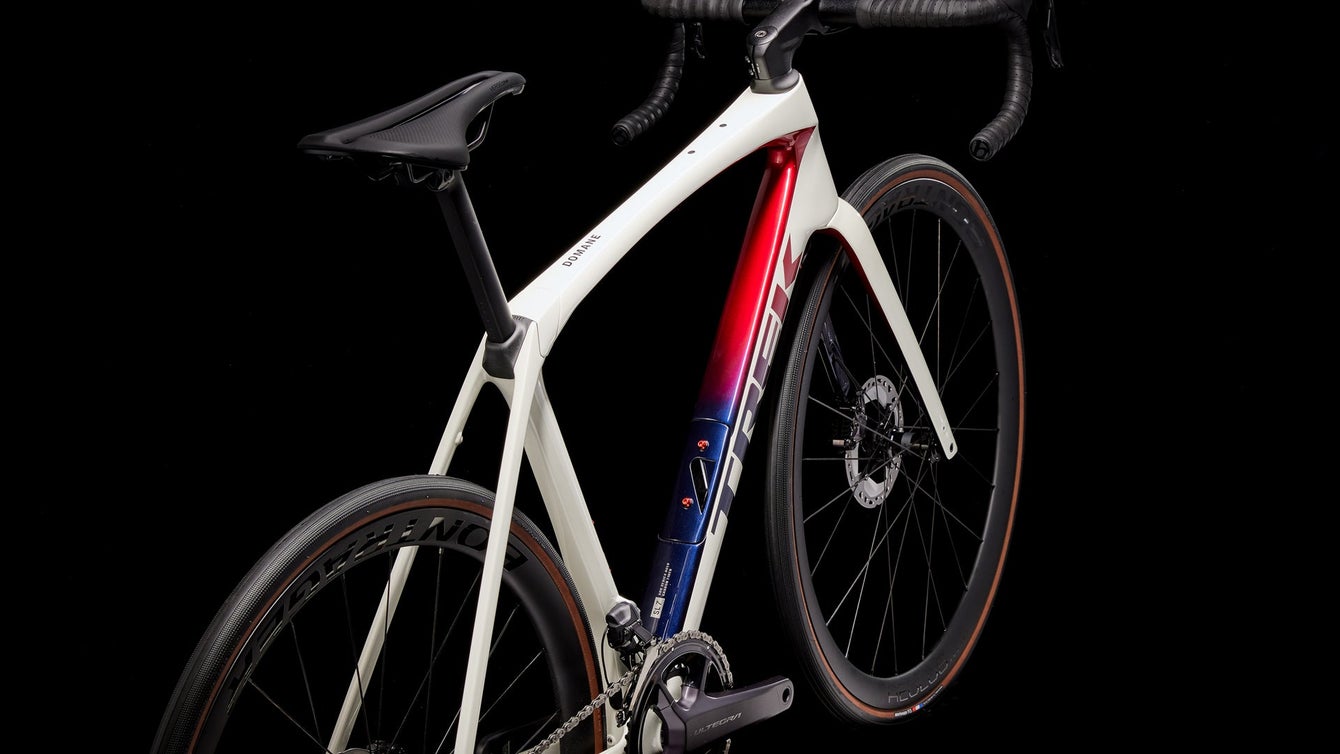
The reasons to walk away from front IsoSpeed are closely related to what was seen with the latest Checkpoint gravel bike . It comes down to modern tyre technology and trends toward going wider in volume. The front IsoSpeed is said to have been beneficial when tyres were 28 mm in size and run at high pressures but is too stiff to make an appreciable difference with a wider-volume tyre system, such as the 32 mm tubeless tyres supplied with the bikes.
Meanwhile, Trek has claimed that the return to its top tube-based IsoSpeed is more effective across the full-size range versus the previous seat tube-based IsoSpeed, which was unintentionally stiffer in smaller sizes. That non-adjustable flex is now said to match the most comfortable setting of the previous generation and is size-specific in the compliance provided.
What’s new is that Trek has moved away from its almost signature upside-down seatpost topper or post-within-a-post designs, and instead adopted its own telescoping D-shaped carbon post. Securing it is a binder wedge that’s integrated with the new IsoSpeed system. The binder is hidden beneath a magnetic cover plate and is designed to work with common pre-set 5-5.2 Nm torque wrenches (or any style of torque wrench). Meanwhile, the proprietary carbon seatpost is being produced in two different set-back versions.
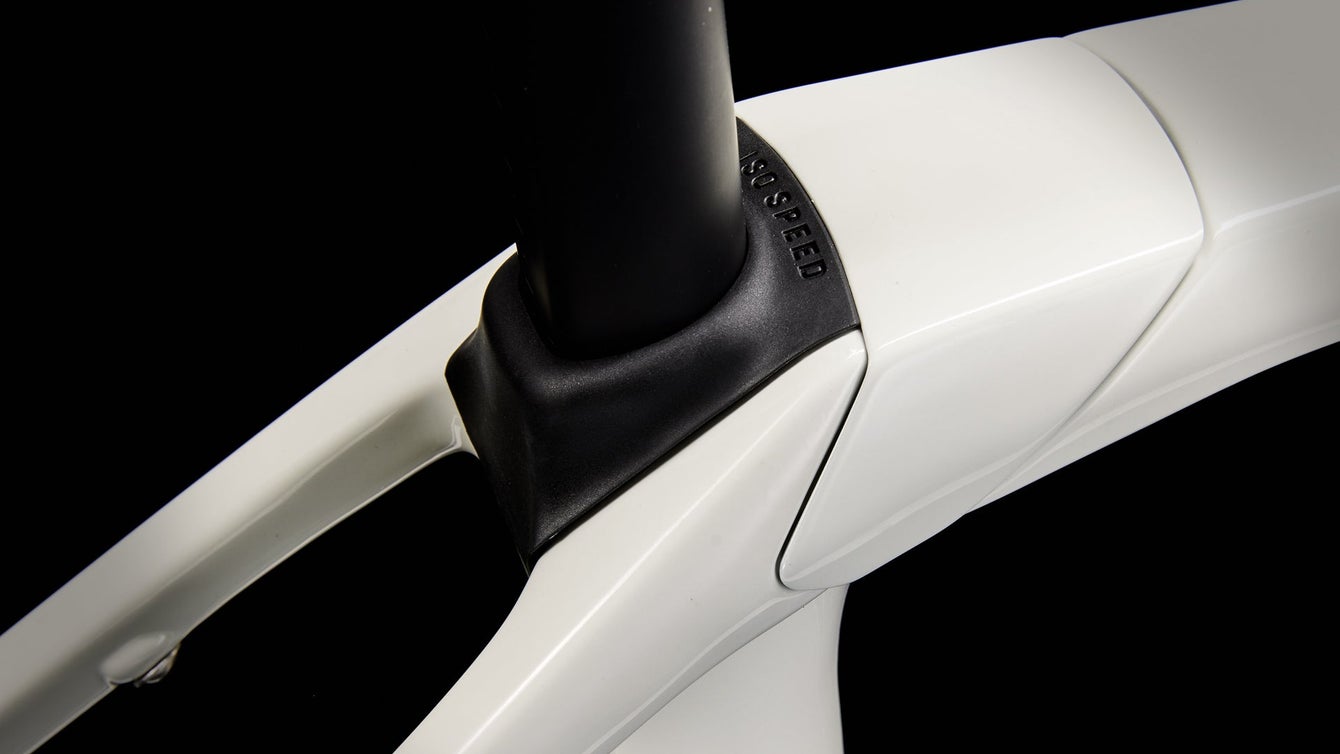
With fewer moving parts the new Domane SL and SLR framesets are approximately 300 grams lighter than before. Additionally, the new SLR version is the lightest Domane Disc yet. Trek quotes 56 cm framesets for the Domane SL (OCLV 500-series carbon) and Domane SLR (OCLV 800-series carbon) at 2,500 g and 1,700 g, respectively. However, precisely what those framesets include is somewhat unclear. Add in some refined Bontrager wheels and the formerly porky base-level Domane SL5 complete bike is now a claimed 700 g lighter – although it’ll still sit above 9 kg with pedals.
The two tiers of Domane share the same moulds and are therefore visually and feature-wise identical. The weight difference is merely down to the Domane SL using a lower modulus “OCLV 500-series” carbon fibre lay-up. In contrast, the Domane SLR uses Trek’s high-modulus “OCLV 800-series” blend (the highest grade of carbon used in the Domane to date) that carries quite the premium pricing. Trek’s entry-level aluminium endurance road bike, the Domane AL – a bike we reviewed in 2021 – remains unchanged.
Not unlike what we’ve seen with other bikes in this category, Trek claims improved aerodynamic performance through features already seen with its Emonda , including revised Kammtail (aka truncated airfoil) shaping and an integrated-ish cockpit with semi-concealed cable routing. That cockpit consists of a two-piece handlebar and stem, where the brake hoses and mechanical gear cables (if applicable) are routed outside of the bar and underneath the new RCS Pro stem, which features a removable cover. The cables/hoses then flow into Trek’s proprietary headset spacers/top cap before being fed through the top headset bearing. And while it’ll look less seamless, the system allows regular stems and handlebars to be used.
Spanning a generous range, the nine available frame sizes point to the popularity of this platform. The Domane SL and SLR keep with Trek’s ‘endurance’ geometry which offers shortened reaches and raised stacks compared to its race-focussed Emonda and Madone offerings. Steering geometry remains on the quicker side for the endurance road category, while the wheelbase is a tad longer than some.
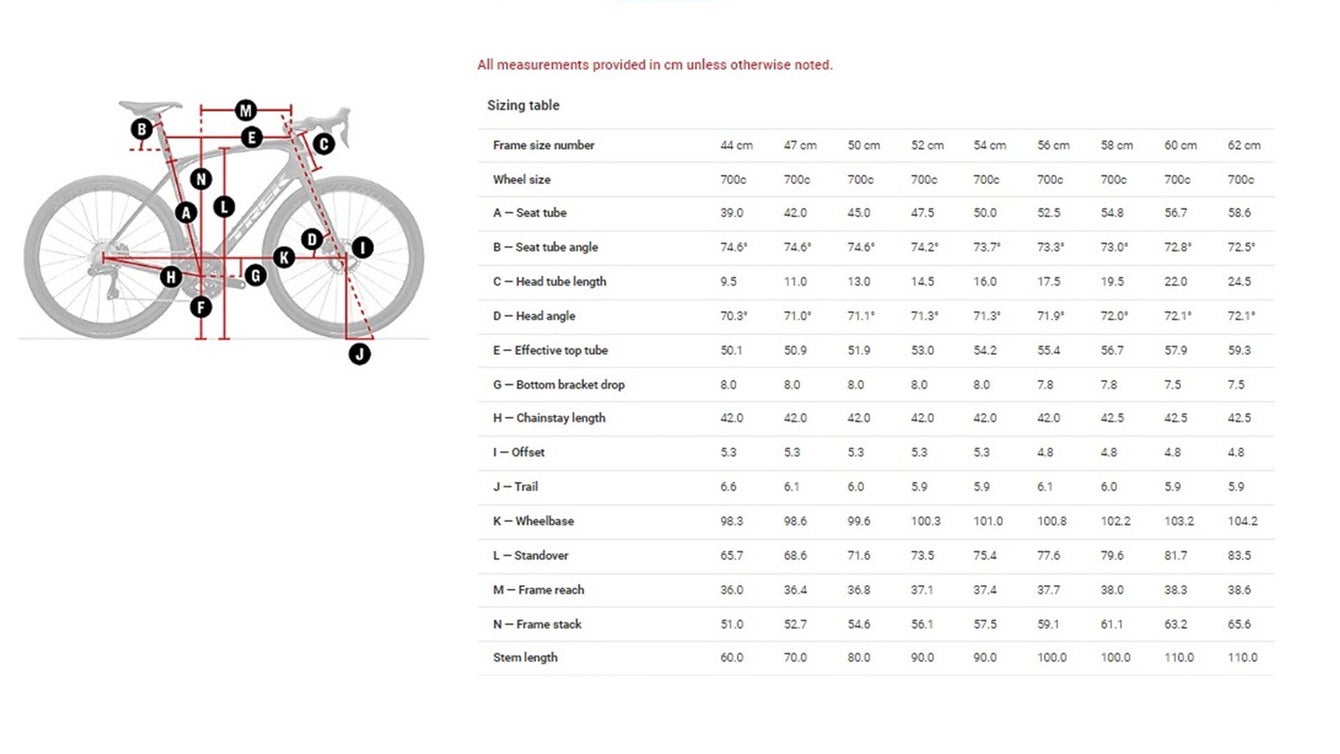
Still ready for all-road use
Trek claims the new Domane is a “road first” platform, but simultaneously talks to its versatility provided by the class-leading 38 mm tyre clearance. That massive tyre clearance remains unchanged from the previous generation and is based on a 6 mm window all the way around the tyre. The figure is based on what Trek considers to be the largest 38 mm-measured tyre width on the market, so there’s plenty of tolerance in here to go bigger than what is officially recommended. All Domane complete bikes come stock with 32 mm tyres.

If I had a way to bang a gong and shout this news, I would. The new Domane spells the end of Trek’s BB90 press-fit system, and the American company’s entire road range now features a threaded bottom bracket. Like we’ve seen with the Madone and Emonda, the Domane uses Trek’s take on the T47 ‘internal’ threaded bottom bracket, one that has open compatibility with all aftermarket T47 bottom brackets and modern crank spindle systems.
Like previous generations, the hidden fender mounts remain, and using those allows for up to a 35 mm tyre to be fitted. Also continuing over is the down tube storage hatch that hides beneath the bidon cage. Within it you’ll find the same tool and tube wrap. Meanwhile, the mounts for a top-tube feed bag remain, too. Another minor and overlooked detail is Trek’s integrated 3S chain keeper which works admirably well.
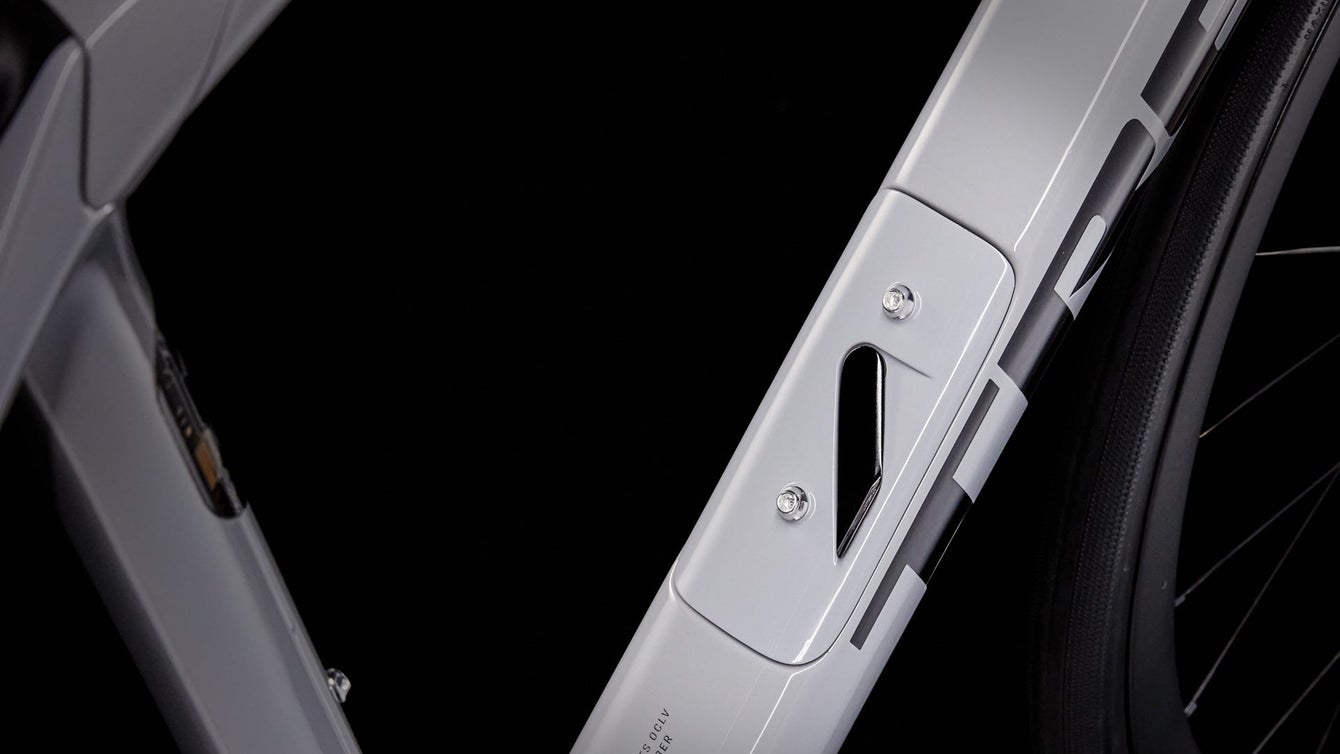
The RSL, a return of the pro version
Go back to the days of Fabian Cancellara skipping across the cobbles and you’ll find that his Domane wasn’t like the one you’d find in your local Trek store. Rather it was a Race Shop Limited (RSL) version from Trek’s Project One range. Sold only in the sizes needed by the key riders of WorldTour team, this pro version combined a race-specific geometry with the wider tyre clearance and smoother frame that the Domane sought to offer. Now Trek has brought the pro version back as a frameset-only option in the form of the Domane RSL.
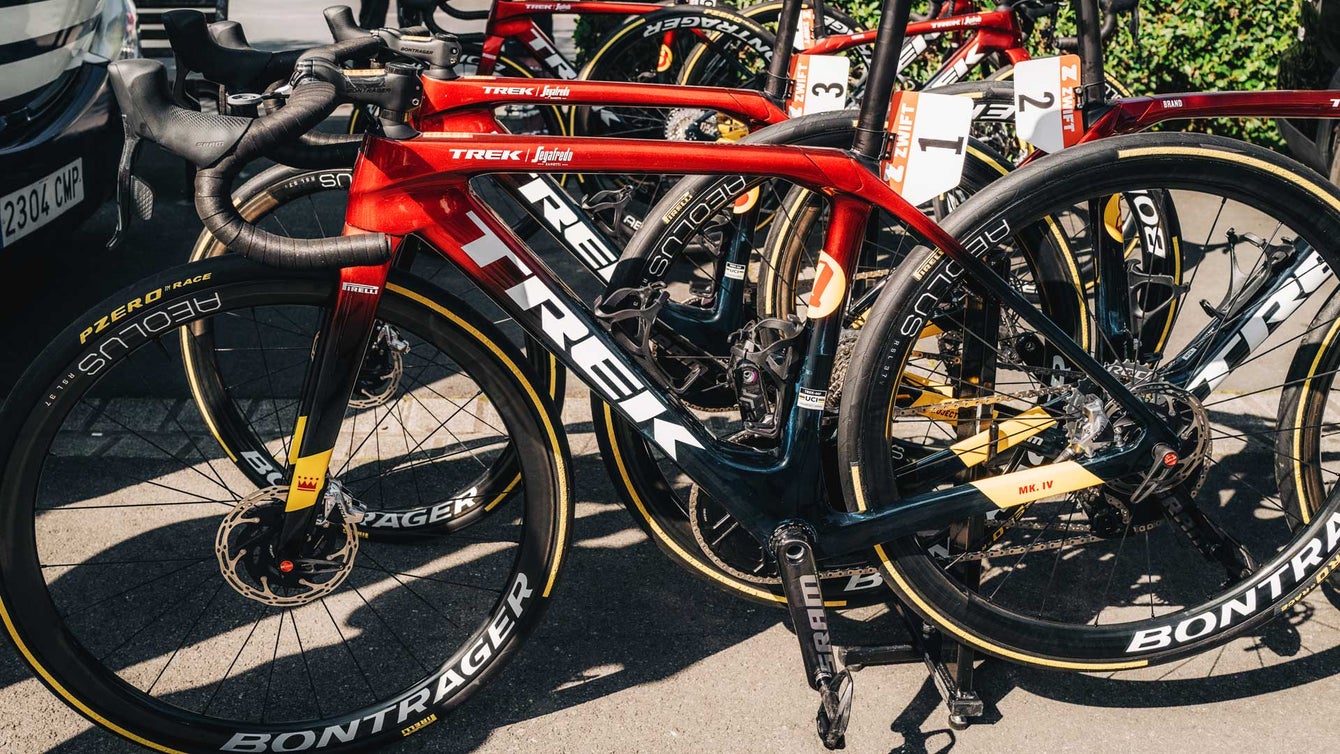
While the regular Domane SL and SLR come in a choice of nine sizes, the RSL version is offered in just five sizes spanning from 52 through to 60 cm. Those five sizes feature Trek’s H1.5 fit which offers more aggressive stack and reach figures in line with its Emonda and Madone bikes. Meanwhile, steeper head angles result in super short trail figures that should equate to a quicker steering characteristic.
There are a few other differences that expand beyond the geometry. Pro riders tend to push bigger gears and the RSL version is designed to clear up to 54/40T rings, or a 54T if run 1x. By comparison, the Domane SL/SLR will only fit a maximum of 52/36T gearing or a 50T single ring. That chainring clearance comes with the trade-off of reduced tyre clearance, with the RSL designed to fit up to 35 mm rubber. And while the SL/SLR framesets can use either electronic or mechanical groupsets, the RSL is electronic-only.
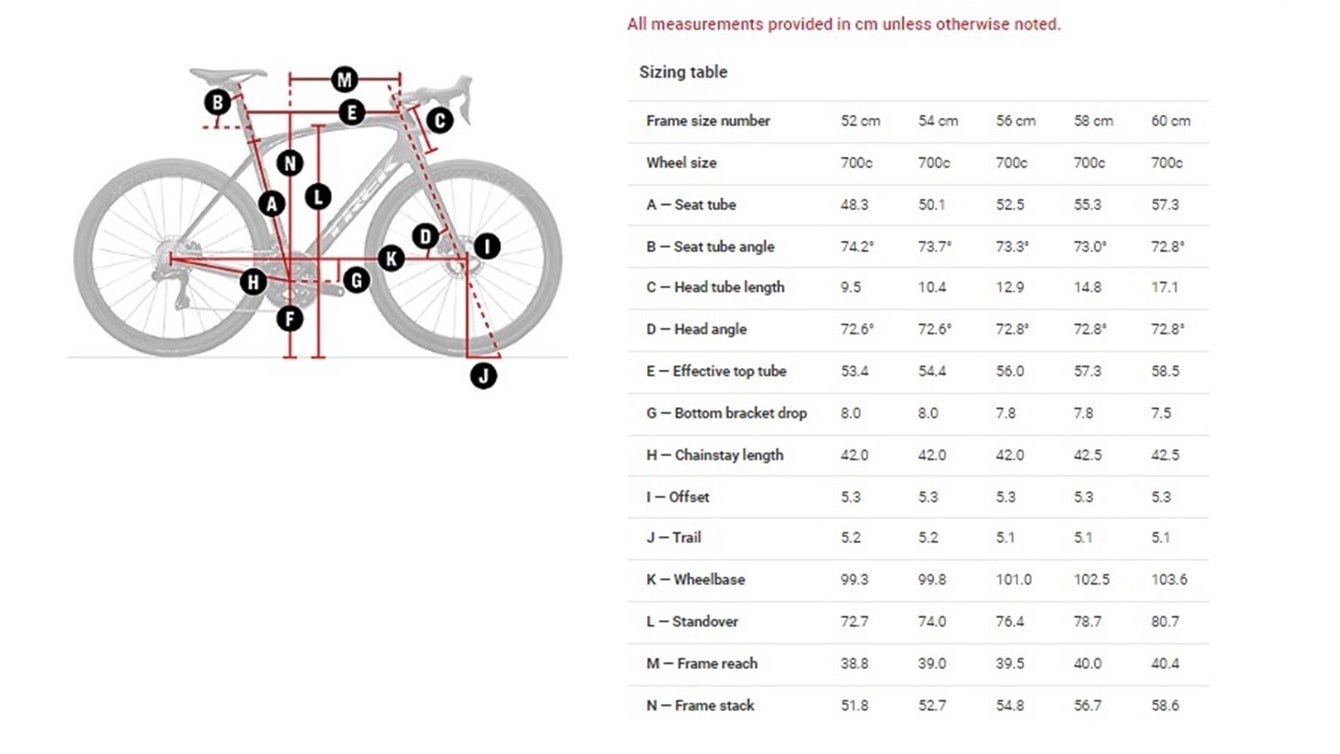
Made with racing in mind, the Domane RSL also drops the down tube storage hatch, the top tube bag mounts, and the fender compatibility. As a result, it’s approximately 100 g lighter than the SLR version.
Models and pricing
There are many complete bike options within the new Domane SL and SLR ranges. Excluding the top-tier SLR 9 eTap (which has Trek-Segafredo team look-a-like Pirelli tyres), all models come equipped with tubeless-ready wheels (hooked bead), Bontrager R3 32 mm tubeless-ready tyres, and tubeless valves and sealant are also provided.
The premium-priced SLR starts with the expected Shimano Dura-Ace Di2 and SRAM Red AXS options, and goes down to models with new Shimano 105 Di2 and SRAM Rival AXS. There are five stock frame colours choices shared amongst the SLR bikes and framesets. A frameset is also available for US$4,200 / €5,000 / £4,500 / AU$NA.

Meanwhile, the lower-cost Domane SL frame is available at the base level with Shimano 105 mechanical, and goes up to models with either Shimano Ultegra Di2 or SRAM Force AXS. And being cheaper doesn’t mean any less choice in paint, with options spanning from boring through to sparkle-drenched. And somewhat unexpectedly, Trek will offer the Domane SL as a bare frameset for US$2,500 / €3,000 / £2,700 / AU$NA.
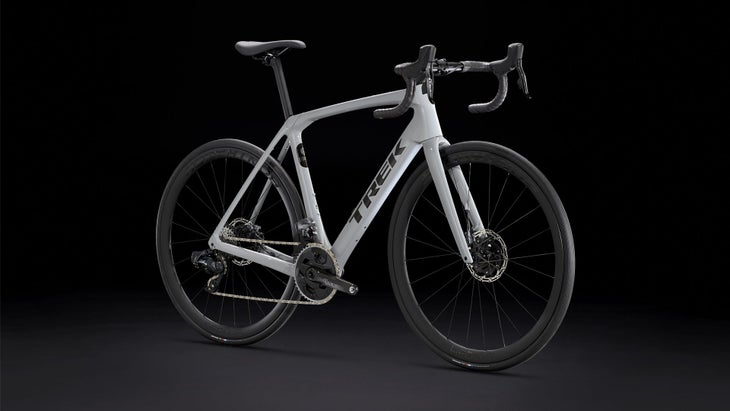
And as already mentioned, the pro-edition RSL is available only as a frameset, priced at US$4,200 / €5,000 / £4,500 / AU$5,600.
Review to come
CyclingTips’s head of tech, James Huang, recently received a new Domane SLR for test, and I plan on borrowing one in October. You can expect a deep-dive review on this new endurance road bike in the coming months.
Popular on Velo
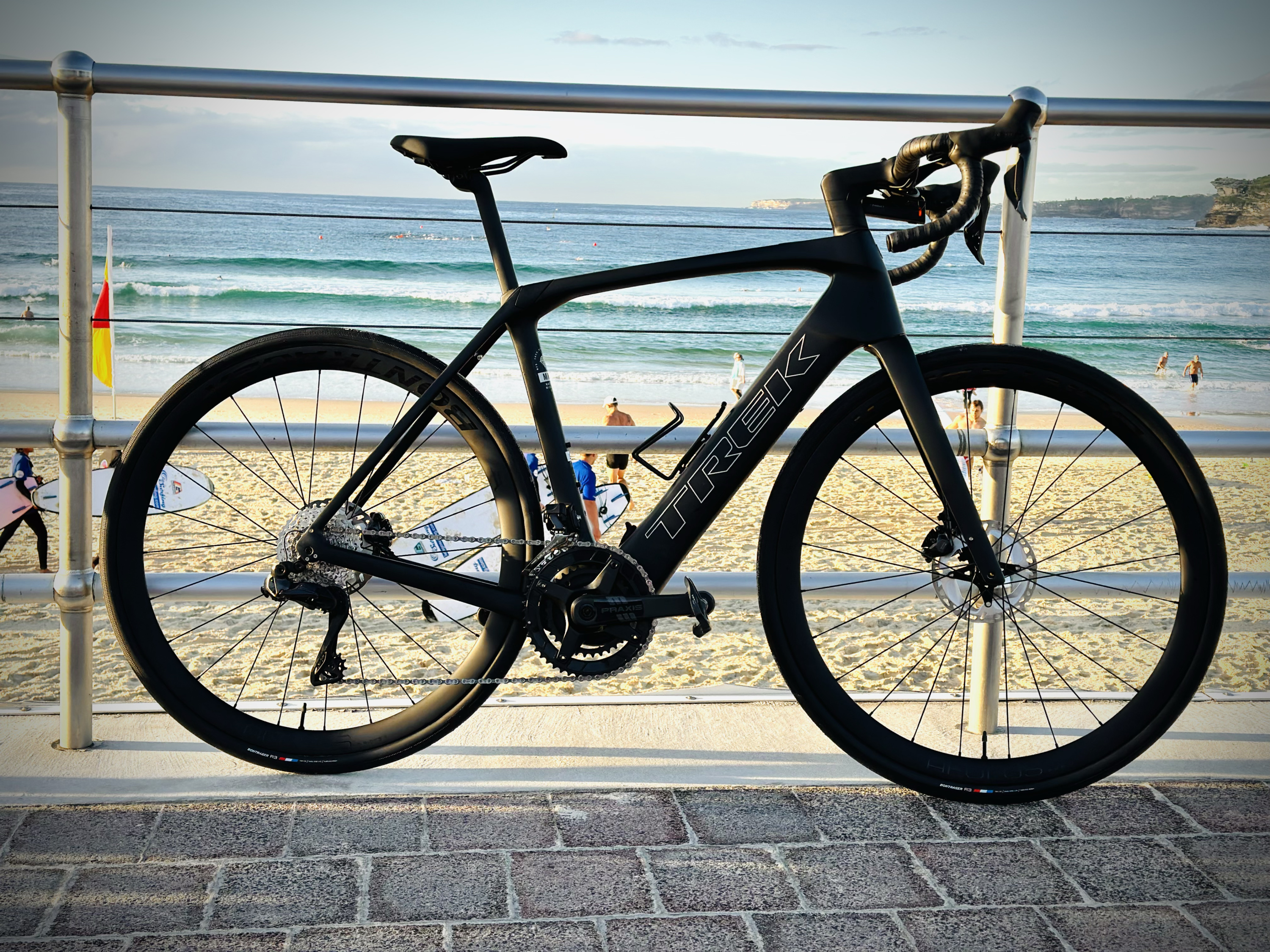
Electric Dreams: We Ride The 2023 Trek Domane+ SLR 7
Peter Maniaty powers up the latest Domane+, the electric assist roadie from Trek.
Well, well. Things are getting interesting. Pedal assist systems used to be oh-so-different to standard road bikes. But change is afoot. As the major manufacturers continue to plough investment into the burgeoning micro-mobility market, once obvious areas of disparity such as aesthetics, frame geometry and weight are converging. It’s happening at remarkable pace, too.
There’s no better example than the next-generation Trek Domane+ which for 2023 gets the full SLR treatment. This deceptively sleek machine looks a lot like a standard road bike. It has virtually identical geometry to a standard road bike. It even handles, largely, like a standard road bike. Given the current development trajectory, it seems entirely feasible there will be virtually no outwardly discernible difference between Trek’s conventional and pedal assist models within a couple of years. Of course, this opens up all manner of possibilities, opportunities and questions. Let’s get to some of them.
How close is the Domane+ SLR styling to a conventional road bike?
Far closer than any other pedal assist bike I’ve ridden to date. Spend some time up close with the 2023 Domane+ SLR 7, or simply pick it up, and it’s still obvious enough it’s an e-bike. It does weigh upwards of 12kg after all, which is around 4kg more than the standard Domane SLR 7. The down tube also remains visibly chunkier than conventional Domane models.
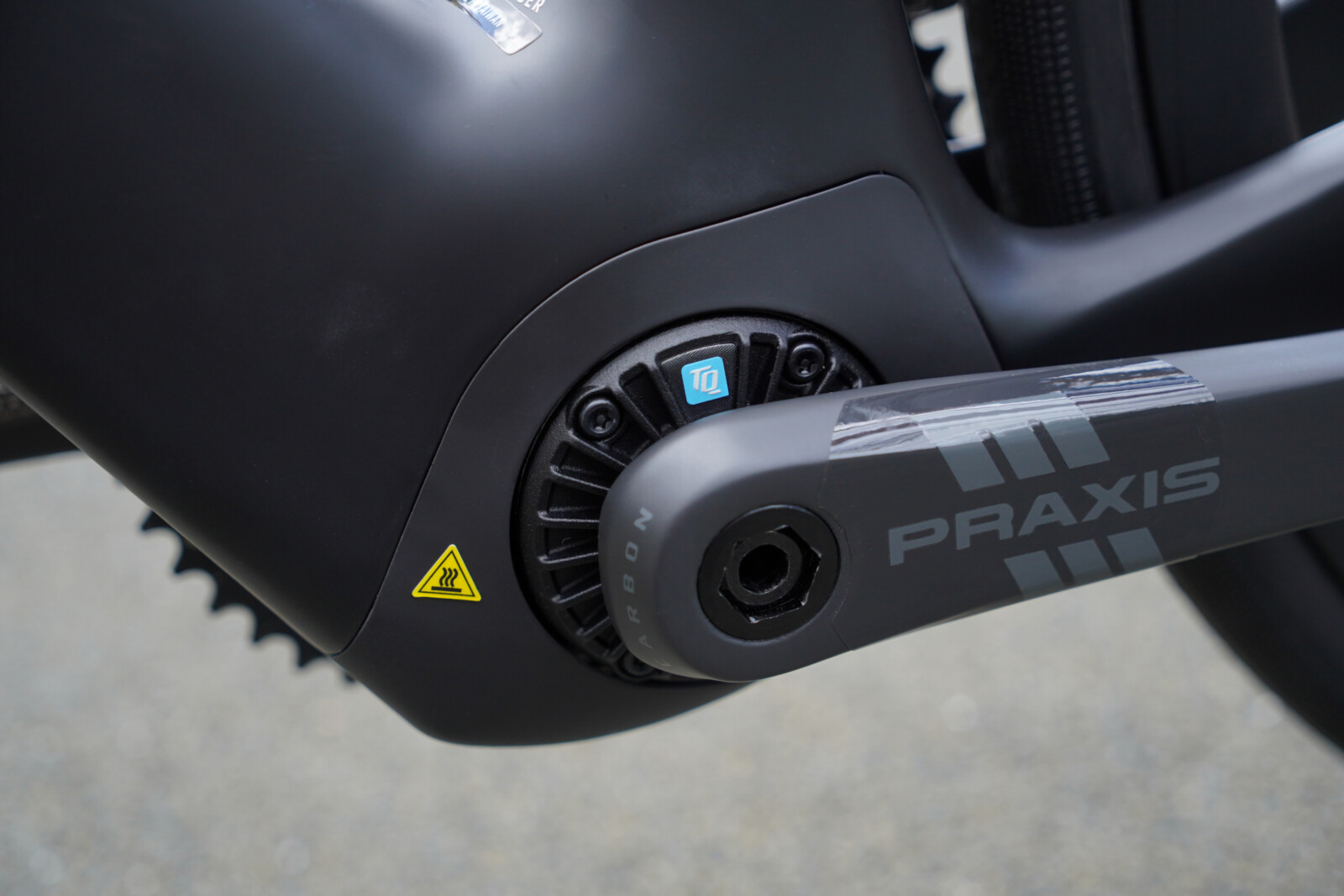
Whilst the oversized bottom bracket junction still features the tell-tale cooling ports for the motor. But here’s the thing. View the Domane+ SLR from even just a few metres away, especially from the front or rear, and you’ll be hard pressed to pick it out in a bunch. Over the course of this month-long review, the majority of people I rode with didn’t even notice it had a motor until I told them. At which point they all became quite fascinated.
How does the geometry compare to the standard Domane?
The key measurements for the 2023 Domane+ SLR are almost identical to the standard Domane SLR, which means an almost identical riding position. This is quite an achievement, made largely possible by the switch to an all-new German TQ motor which is considerably more compact than previous iterations, allowing for more normal frame proportions, especially in and around the bottom bracket.
The Domane+ SLR frame is built to Trek’s standard H2 endurance geometry with a taller head tube and longer chain stays for greater comfort and stability. The build also features the same D-shaped seat post, IsoSpeed decoupling system and integrated cable routing as the standard Domane SLR. For me, the only noticeable difference was the Q-factor which, whilst certainly more forgiving than most other pedal-assist road bikes, is still around 16mm wider than my day-to-day roadie. This may not seem like much, but it definitely shifts your knee alignment and I certainly noticed it. (Or, more accurately, my knees and hips did.)
How does it compare to earlier Domane+ models?
The previous Domane+ was good. But the 2023 model is another major leap forward, delivering a package that’s noticeably slimmer and quieter. It’s also the first pedal-assist bike to use Trek’s highest grade 800 Series OCLV carbon for both frame and fork; an upgrade that in tandem with the new motor has helped to shave significant weight from the previous Trek Domane+.
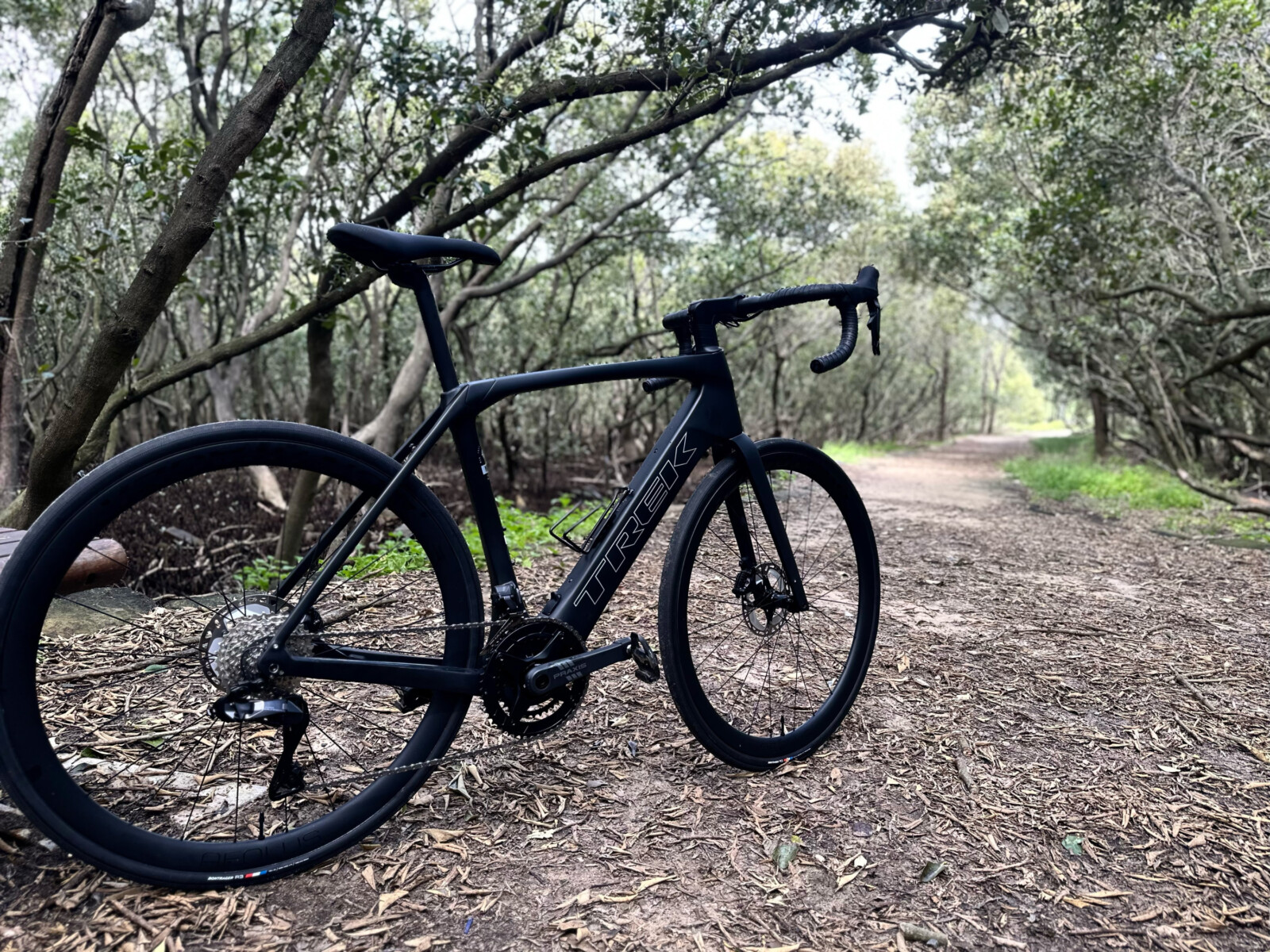
By way of comparison, the original Domane+ tipped the scales at a hefty 17.1kg (56cm), whereas the 2023 model is now just 12.2kg. Still heavy, for sure. But you don’t need a mathematics degree to see this number is coming down all the time.
What motor is Trek using in 2023?
Trek has never been hesitant to flip motor suppliers. In their ongoing quest for e-bike supremacy they have done so again in 2023. This time, the Domane+ SLR features the same TQ HPR50 mid-drive system you’ll find on Trek’s Fuel EXe e-mountain bike.
Whereas most e-bike motors tend to use gears and belts to drive you forward, the German-designed TQ motor instead features a harmonic pin ring transmission discreetly tucked away behind the chain ring. Power wise, the TQ HPR50 system delivers 50Nm of torque which is actually slightly less than the 55Nm offered by the previous Domane+ motor (Fazua Evation). However, at just 1,850g the TQ system is both lighter and smaller, which translates to reductions in overall weight and tube profiles. Importantly, the TQ HPR50 also has fewer moving parts and, according to Trek, is significantly more durable.
Banishing noisy belts and gear teeth to the dustbin also makes it v-e-r-y quiet. Listen closely in the still of the early morning and you can just make out a faint whirring sound. During the day you’ll struggle to hear it at all.
How about the battery?
The Domane+ SLR is powered by a 360Wh Li-ion battery (1,835g) which is integrated directly into the frame. Charging is super simple; you literally just have to plug it in. A full charge takes around two hours. I found the run time pretty good too. On one ride out to Bondi and Watsons Bay I travelled 82km with nearly 1,000m of climbing, and still had 34 per cent charge left.
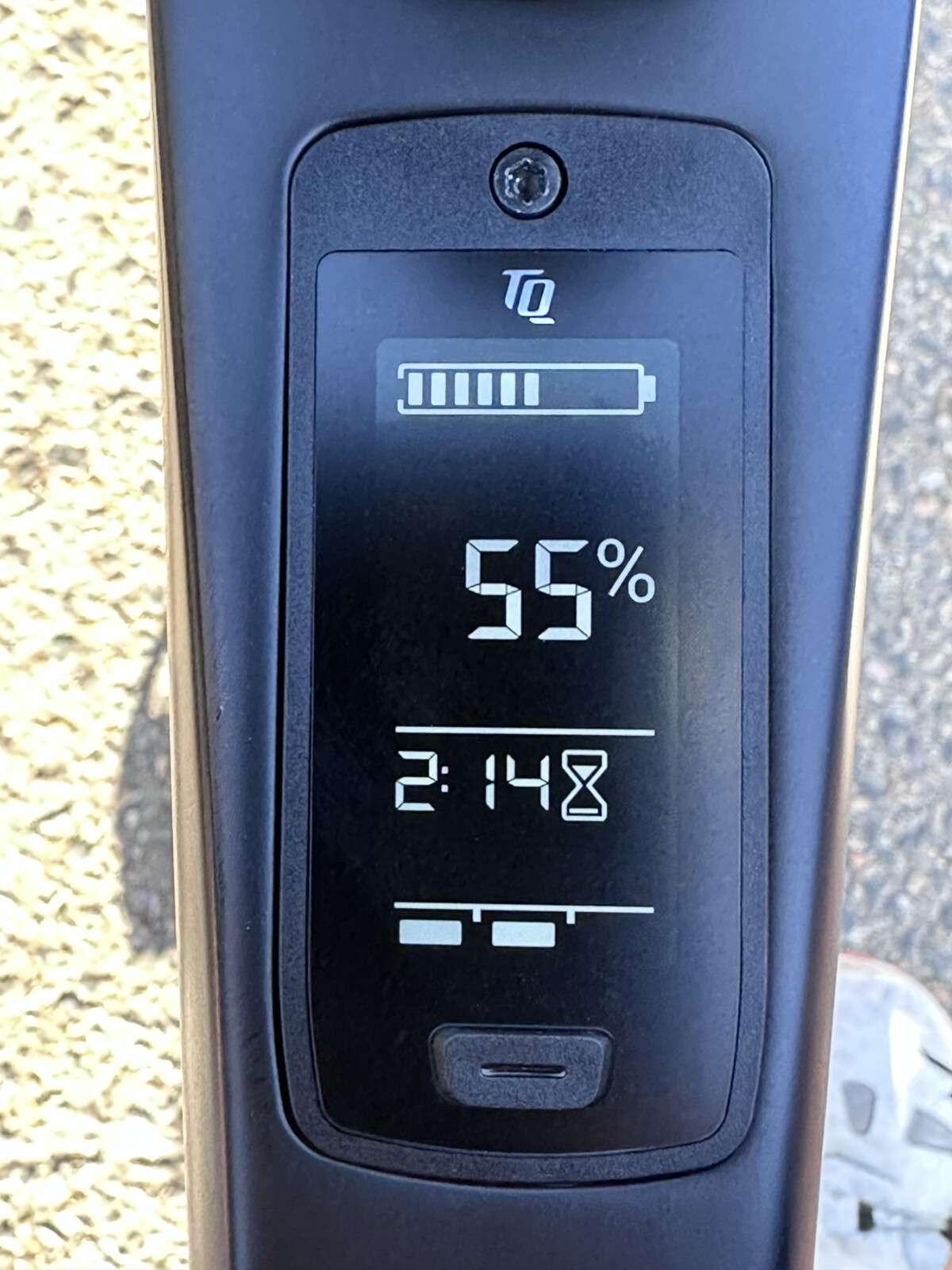
On another trip up to Bobbin Head, I covered 65km, again with plenty of climbing, and returned home with 45 per cent of battery still in the tank. Trek says the main 360Wh battery will take you around 100km in eco mode, although this obviously depends on other factors like weight, riding conditions and terrain.
Trek also sells an optional 160Wh range extender battery that can add around 45-50km extra for longer rides. It sits in the seat tube bottle cage and weighs around 900g, not much more than a full bidon. Of course, simply switching the motor off when you don’t really need it should extend battery life, too.
How easy is it to operate?
Incredibly easy. The TQ system is thoroughly intuitive with simple controls accessed via small buttons located on the inside of both hoods. In all, there are three modes providing increasingly higher levels of assistance. Click right to shift up. Click left to shift down. Or hold the left button down to turn the pedal assist off altogether.
What about the drivetrain and other components?
Similar to its non-powered namesake, the SLR 7 sits second in the Domane+ range. The review model was equipped with an impressive array of componentry led by the 12-speed Ultegra R8170 Di2 wireless drivetrain and Praxis 50/34T carbon crankset. As you’d expect from Trek, the finishing kit is Bontrager all the way with Pro Iso-Core handlebar, integrated RCS Pro stem and a very comfortable Verse Short Elite saddle.
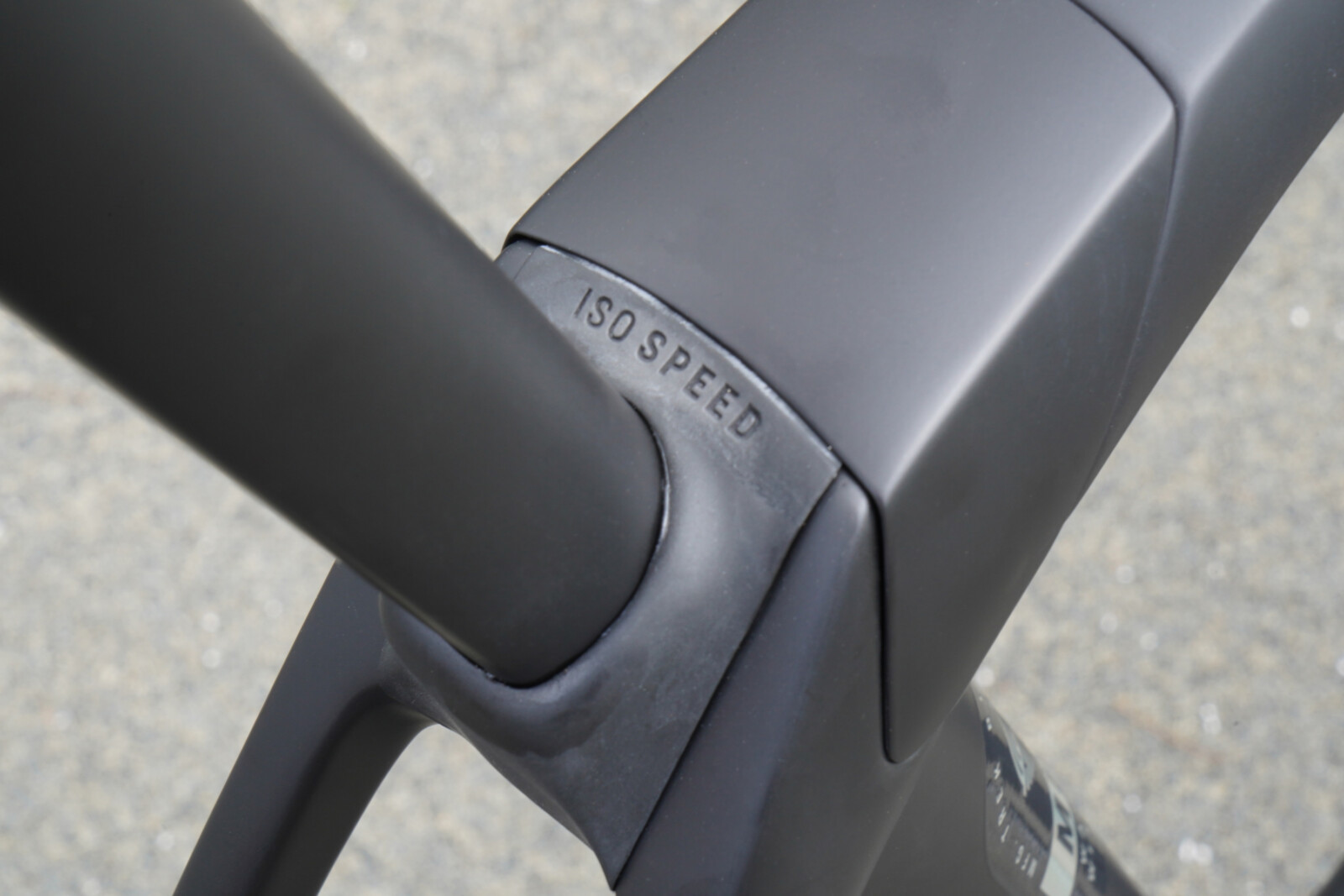
The super-versatile Bontrager Aeolus Pro 37 OCLV carbon wheelset fitted with 32mm Bontrager R3 tubeless tyres (maximum tyre size is 40mm without panniers) is another perfect addition. It’s also worth noting the TQ motor system provides real-time power, ride and battery life data via a high-resolution LCD screen integrated into the top tube.
How does it ride?
First things first. This is not a motorbike. The Domane+ SLR uses a pedal assist system where the power assistance is relative to the energy you put through the pedals yourself. This means cadence and gear selection still matters. In fact, learning to master the different gear ratios for different terrain and speeds is probably the single biggest learning curve when you first start riding. Once you get that right, it’s a dream.
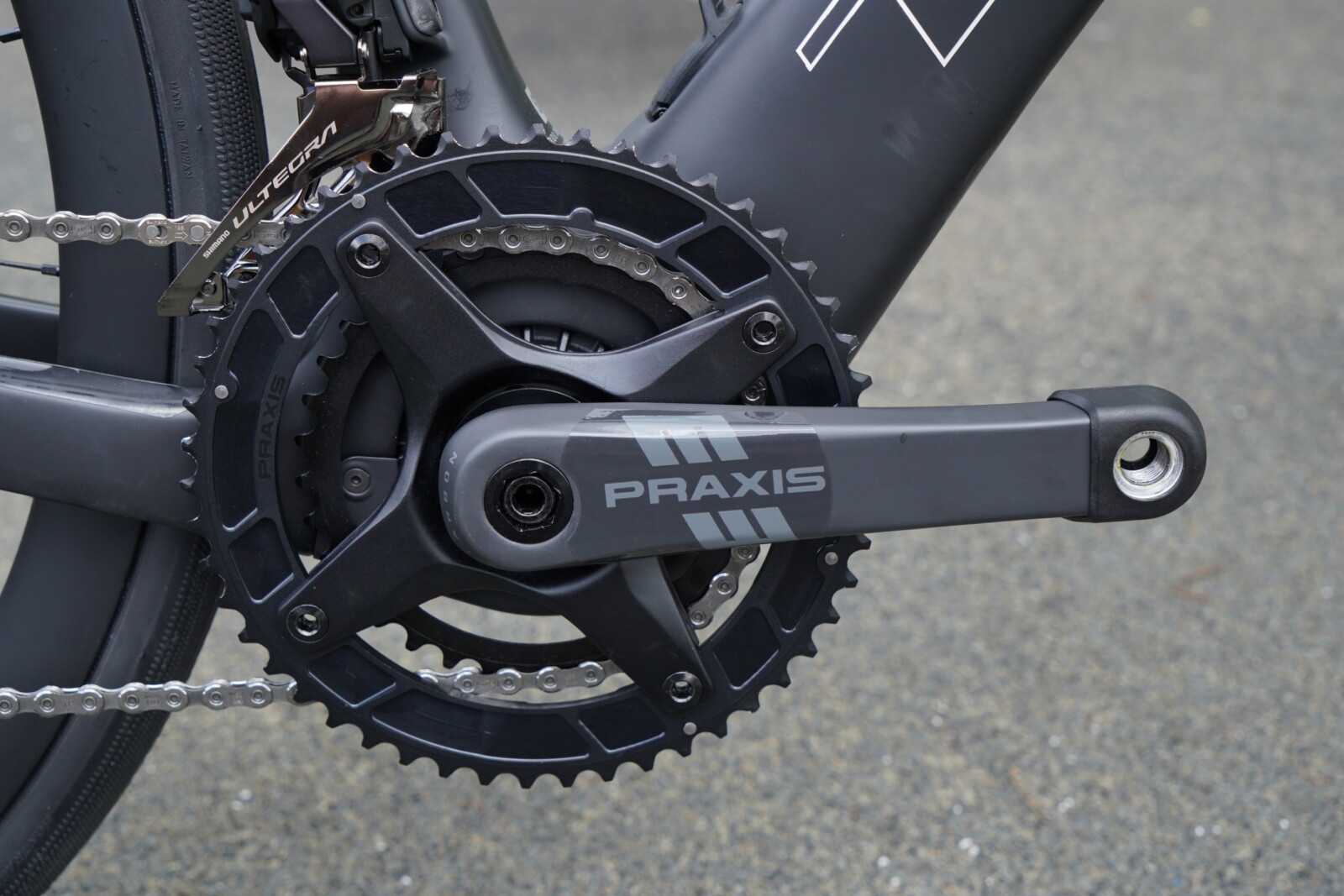
Out on the road, the relaxed geometry, extra weight and lower centre of gravity makes it very stable and reassuringly well behaved. On the flip side, it also makes acceleration a little lacklustre. That said, with the pedal assist turned on it still jumps away from a standing start, something that consistently brought a smile to my face.
Handling wise, the Domane+ SLR is smooth and steady, rather than agile and snappy, sweeping confidently through turns whatever the speed, gradient or road surface. With the 28mm tubeless tyre set up on the review model (I was mostly running 65-75psi), I also found it very forgiving over the bumps. The motor engagement is smooth and reasonably subtle; nowhere near as jerky and dramatic as many earlier models of e-bikes. This all makes for a pleasant and seamless riding experience across pretty much any terrain.
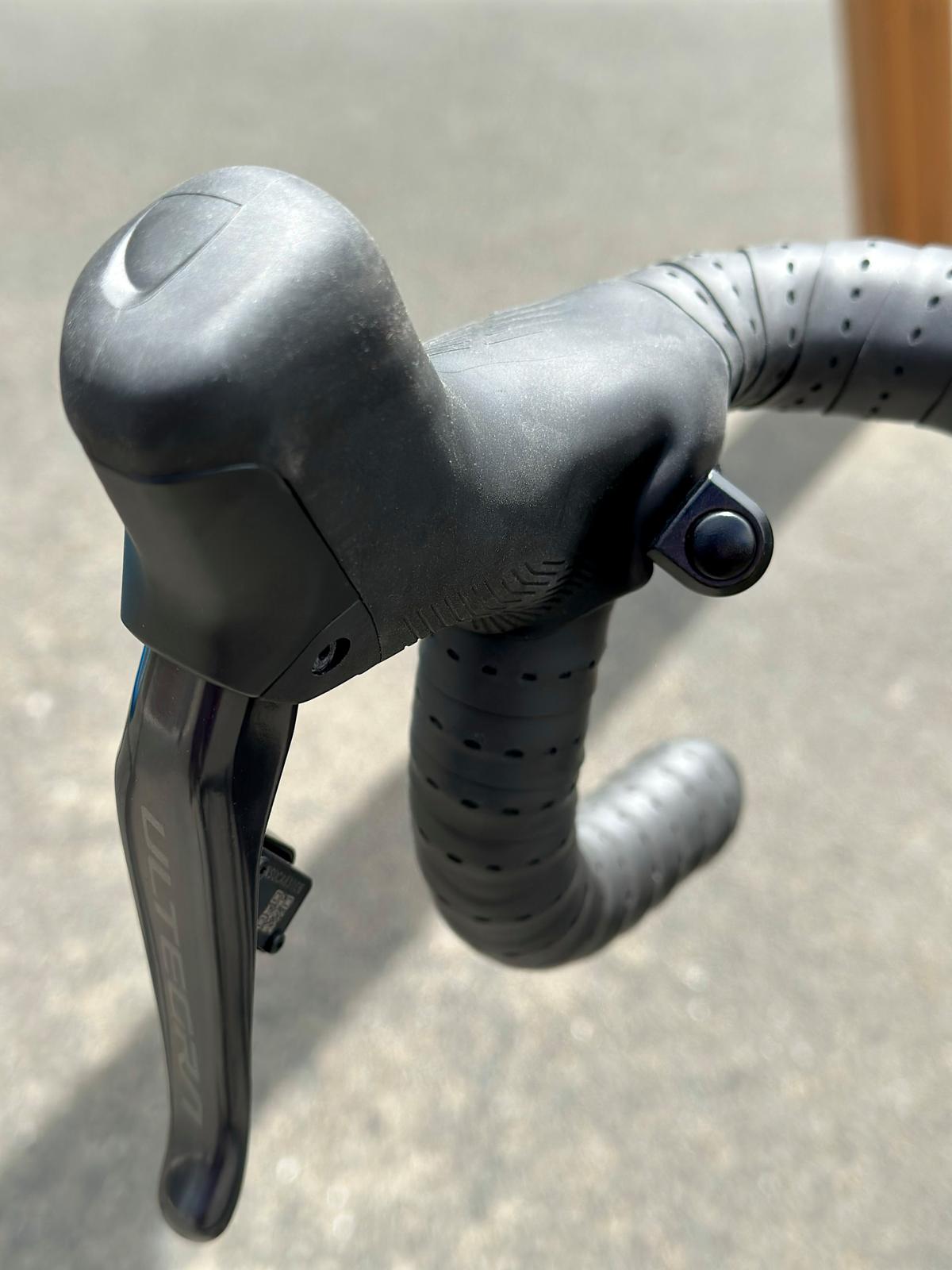
Of course, flattening out the hills is clearly the sweet spot for the Domane+ SLR. Yes, you still have to work. But whether it’s a 20km alpine climb or just a 50-metre pinch on your local bunch ride, rest assured you will find yourself smirking when most around you are suffering. On more than one occasion I actually felt a little guilty as I cruised past riders clearly fitter and faster than me under normal riding conditions.
Somewhat paradoxically, the faster Domane+ SLR goes, the more sluggish it becomes. This is because the motor – whilst capable of speeds approaching 45kmh at full power – is limited to a maximum assist speed of 25kmh in Australia. Beyond that it cuts out and you’re on your own with, effectively, just a very heavy road bike.
Who is it for?
It’s the critical question, but also a hard one to answer. Frankly, there are many types of riders who could potentially enjoy this bike. People looking to keep up with their younger and/or fitter mates. Those recovering from – or permanently affected by – injury or illness. Partners of riders who’ve always wanted to tag along but have never had the confidence or fitness to try. Commuters who want a classically-styled road bike that won’t leave them as hot and sweaty when they get to the office each morning.
Committed roadies who want a second bike for gentle rides when they’re looking to rest their legs. Panniers and mudguards can also be fitted, meaning touring and gravel are other genuine options, although battery life and charging logistics could be an issue depending on the route and location.
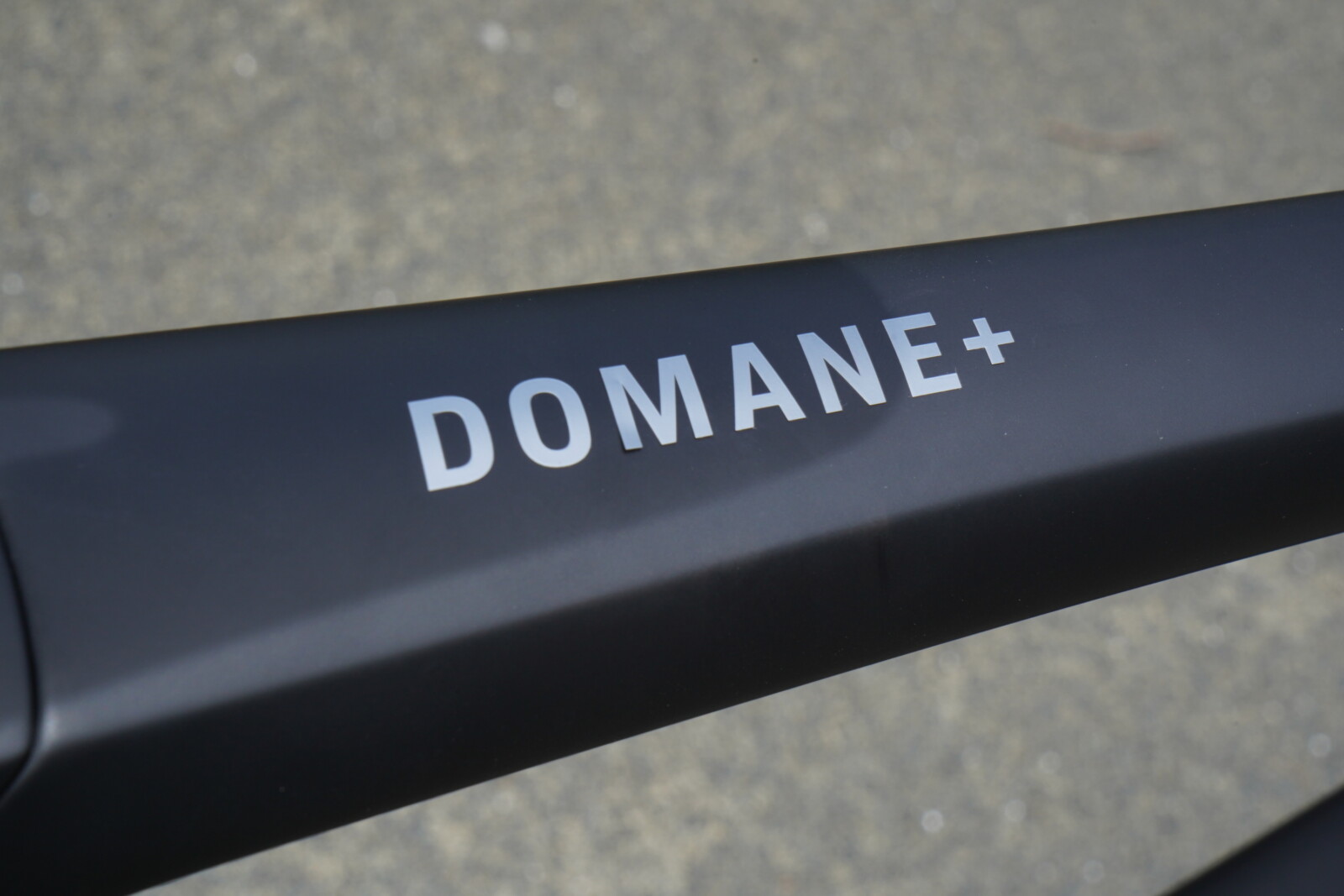
Are there any drawbacks?
There’s really only one limitation to this fabulous bicycle and that’s the 25kmh motor cut-off mentioned earlier. This, of course, has nothing to do with Trek or the Domane+ per se. It’s a blanket government regulation in Australia that applies to all micromobility devices like e-bikes and e-scooters. Based on my experiences, this will significantly reduce the usefulness of the Domane+ SLR for many road cyclists. Whilst ideal for commutes, cruisy rides and routes where you are predominately pointing upwards, if you’re likely to be travelling for extended periods at upwards of 30kmh on flat to rolling terrain, the extra weight will become a factor. Sure, you could consider turning to the dark arts and get someone to over-ride the speed settings. But in addition to being illegal, you run the very serious risk of voiding any insurance coverage in the event of an accident. Do. Not. Do. It.
The 2023 Domane+ SLR 7 is a remarkable piece of two-wheeled engineering that brings two very different worlds closer together than ever before. Fantastically designed and finished, it’s a brilliant choice for some riders. Yet an absolutely terrible choice for others. As motors, batteries and frame sizes continue to tumble for pedal assist bikes – bringing overall weight and aesthetics ever-nearer to conventional bikes – it offers an exciting glimpse of the future.
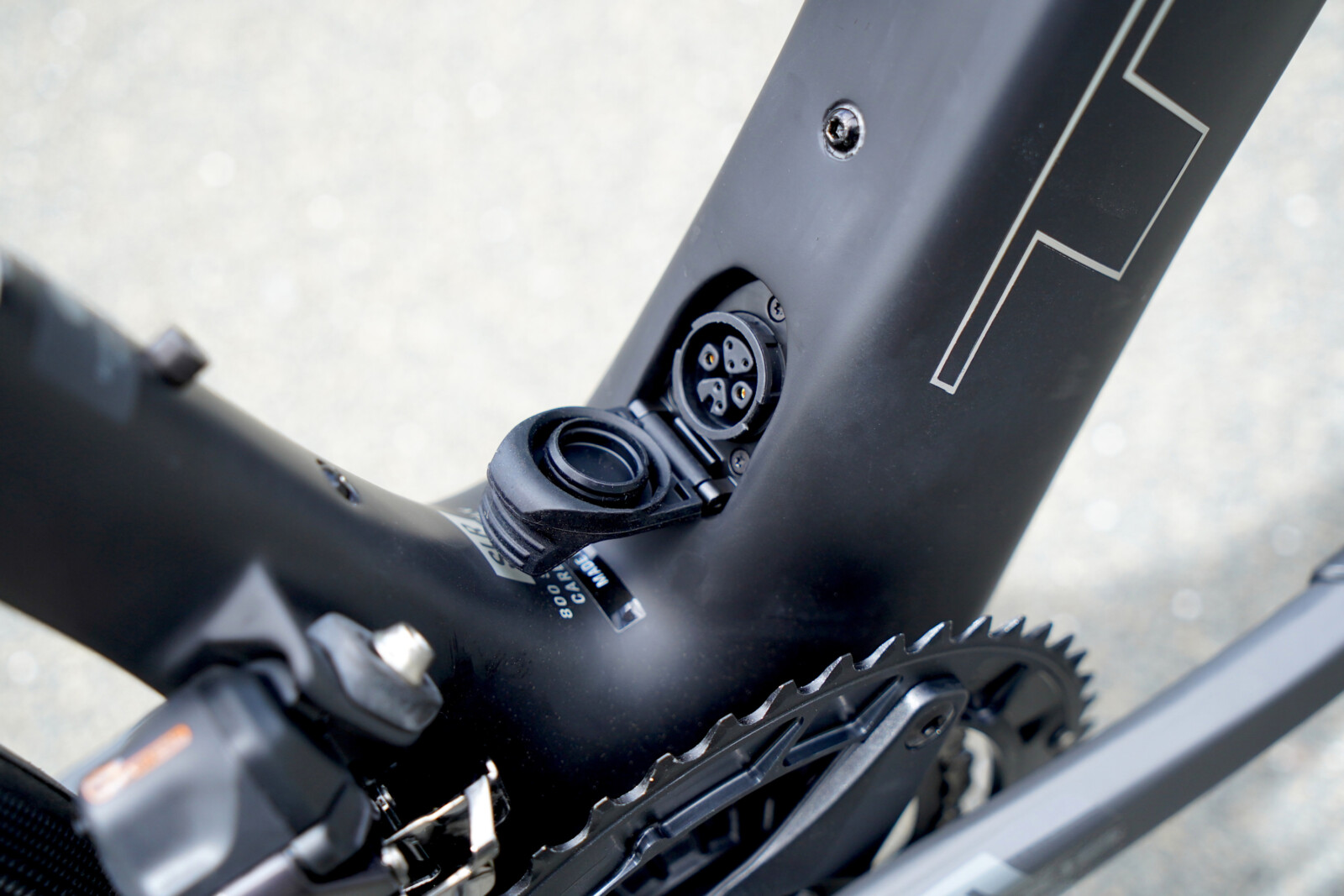
“…the majority of people I rode with didn’t even notice it had a motor until I told them…”
Wonderfully designed and finished with top-notch OCLV carbon, TQ motor and high-spec components. This is about as good as pedal assist road bikes get.
Performance
Stable and smooth, the Domane+ SLR is a true endurance machine, as comfortable as it is versatile. The only thing stopping you from riding it all day is the battery range.
Value for money
Yes, $14,490 is a lot of money. But it’s also a fantastic bike that gives you a lot in return. As long as you’re able to ride it regularly, it will likely be worth every dollar.
The Domane+ SLR is an outstanding pedal assist road bicycle with a significant asterisk. Spend most of your time riding under 25kmh? You will love it. Otherwise, probably best to look elsewhere.
HAVE YOUR SAY Cancel reply
You must be logged in to post a comment.
What do you think?

Review – Tour de France: Unchained

Edition #242 Of Bicycling Australia Magazine Out Now!
© 2024 by Yaffa Media. All rights reserved.
With social network:
Forgot password.
Enter your account data and we will send you a link to reset your password.
Username or Email Address
Your password reset link appears to be invalid or expired.
Privacy policy.
To use social login you have to agree with the storage and handling of your data by this website. Privacy Policy
Add to Collection
Public collection title
Private collection title
No Collections
Here you'll find all collections you've created before.
- Domane SLR 7
- Tour de France stage 1 Live - Hilly race to Rimini to decide first yellow jersey
Trek Madone Gen 8 SL7: First ride review
Trek's new madone supersedes its aero champion and kills off the emonda altogether - so is this one bike to rule them all.

Early Verdict
The new Madone has big shoes to fill by replacing two of the most impressive bikes on the market, but initial impressions indicate it's done just that
Fantastic ride quality and comfort
Rigid in power transfer and handling
Stunningly light
A blisteringly fast bike
The accompanying water bottles may take some getting used to
You can trust Cyclingnews Our experts spend countless hours testing cycling tech and will always share honest, unbiased advice to help you choose. Find out more about how we test.
It’s hard to conjure a bike more iconic to pro cycling than the Trek Madone. The Madone was born out of the glory years of Lance Armstrong’s now-shamed successive Tour de France wins, and named after his key training climb – the Col de la Madone. But the Trek Madone achieved the rare feat of surviving the Texan’s fall from grace and living on independently with its own unique legacy.
The Madone Gen 8 is arguably the most true-to-nature version of Trek’s flagship racer since its original iteration - combining the aerodynamics of the previous Madone with the lightweight design of the Emonda and doing away with the latter model altogether in the process. It brings Trek’s entire performance road bike line back to basics - the Domane is still there for the comfort-cum-cobble market, but the Madone is now Trek’s one and only flagship racer. In the years before the dedicated aero bike, that was the norm, and Trek claims to have returned to that with no downside.
Trek claims that the new Madone SLR hits a frame weight of 765g and a fork weight of 370g, making it the same weight as the outgoing Emonda. It also manages that while exceeding the aerodynamics performance of the previous aero-focussed SLR - by a slender 0.1 watt at 22mph (and marginally faster all the way up to 40mph).
With its shift back to narrow tubes and lightweight performance, alongside the end of the Emonda, it seems fitting to pull back and take a look at how the Madone evolved to reach this latest and perhaps most complete iteration.
The Trek Madone - from the start and back again
Originally billed as an aerodynamic lightweight racer in 2003, it didn't dazzle in weight terms and aerodynamics was limited to a fin on the seat tube. The bike arguably didn’t disrupt that status quo until its second iteration in 2007, and in 2009 came a sub 900g OCLV masterpiece in the bike’s third and most iterative design. However, it still looked, largely, like a bike.
In 2015 that was no longer the case, as Trek unveiled a new Madone which completely transformed the genre. In (unintentional) sync with the launch of the Specialized Venge Vias, the Madone 9 series was the first road bike to completely conceal its front cabling – making the front of the bike completely clean with the help of integrated Bontrager brakes developed specifically for the Madone. To facilitate that, the headtube of the bike had retractable carbon flaps which would open when the handlebars were moved to an acute enough angle, in order to let the brakes pop out from within the headtube.
This was a truly unhinged design (albeit with actual hinges) which offered a seismic leap in aerodynamic performance and overall speed - I attended the launch in 2015 and assumed I was suffering from jetlag delirium. The weight suffered as a result of the aero design. That was exacerbated by the IsoSpeed decoupler on the seatpost which compensated for the harsh aero tubes. In the era of rim brakes and early aerodynamic advances, though, overall weight being a kilo over the UCI minimum weight limit was nothing compared to the enormous watt savings.
Since then, the Madone developed an adjustable IsoSpeed and gained disc brakes which negated the carbon flaps, before gradually converging back toward a more all-around bike. The 2022 update of the Madone sided for lighter weight at the expense of the IsoSpeed, providing instead an exhaust-like cantilever chasm in the seat tube known as the IsoFlow - still present in the design of the Madone Gen 8.
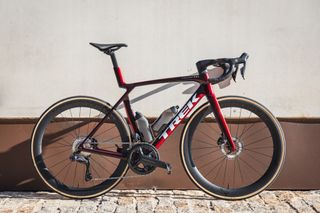
Indeed, having already taken a step toward being an all-around racer, the Gen 8 looks like the last generation Madone has been on a diet with thinner tubes, radically reshaped for aerodynamics and comfort, all powered by improved 900 OCLV Carbon – Trek’s proprietary blend of carbon fibre.
On the whole, though, Trek’s goal was clearly to make an irrefutably fast bike, which wins both on the ascents, descents and solo into the wind.
More of everything
“To our knowledge this is one of the if not the fastest road race bike that exists within the professional peloton and in the market,” says Jordan Roessingh, Director of Road bikes at Trek.
“When you're comparing both attributes [weight and aero] of either previous platform, it's 77 seconds per hour faster than Emonda. So that's an enormous difference in aerodynamic performance compared to the previous Emonda despite the fact it's the same weight.”
The real sell is that the new Madone nails the Emonda’s weight while matching the previous Madone’s aerodynamics. “When you're comparing to a Madone, it's the exact same aerodynamic performance,” Roessingh says. “But 320g lighter – so an enormous weight saving between those two. So again, we're taking the best of both worlds here and merging them and still achieving the highest performance of both attributes.”
The new tube shapes play a big role in the lower weight, better ride and claimed aero benefits. It’s odd as the cross-sections of the aero tubes look blunt and devoid of aerofoil or Kamm-tail shaping. However, when taken as a whole system, sandwiched between a horizontal cross-section of the front rim profile, aero bottles and the rear bottles, the tubes form a sort of neat holistic aerofoil.
Said with almost a grimace, as it’s become an industry cliche, Trek boasts that the bike has better vertical compliance alongside more lateral stiffness. The central IsoFlow seat tube gap claims an 80% improvement in the Madone’s vertical compliance and a 24% improvement over the IsoFlow-less Emonda.
The new Madone carries over the same splayed integrated bar concept as the Gen 7 - positioning the rider 2cm inward on the hoods compared to the drops for aero gains while sitting on the hoods (which has increasingly become the standard aero position).
Strangely, Trek claims the handlebars are less aerodynamic than the Gen 7 iteration, but with a wider cross-section offer a better overall aero performance when air interacts with the bars and then the rider.
In another gravel-like nod to versatility, the new Madone has clearance for 33mm tyres - up from 28mm on the previous Madone. Trek argues that the previous Madone could have handled 30mm or larger in most rim combinations, and for the Gen 8, similarly, 33mm is a conservative estimate. We can believe that given the visible clearance.
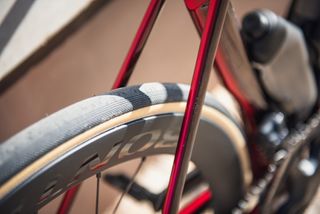
Sizing, spec and bottled-up speed
Trek’s aero bottle design is intriguing because this is ground that the bike market had trodden before. Aero water bottles have been commonplace in triathlon and time trial for over a decade, and have crept up into the build of aero road bikes from time to time but never managed to break through.
It’s also intriguing because the Madone is slower than its previous iteration with round bottles. What’s more, without any bottles on the bikes at all, it’s slower - so no ditching your bottles at the base of the climb.
Given the fixation on aero gains, it’s surprising that the claimed 3.7-watt gains with Trek’s RSL water bottles haven’t been adopted across the peloton. In reality, though, aero bottles present a few issues. Typically the aero cages restrict the use of round bottles, while any minor challenge in liberating a bottle is a big issue to a WorldTour rider on a critical climb. Trek claims to have solved both of those problems.
“These bottle cages are compatible with round bottles” explains Adam Bird, Trek’s Design Engineer for the Madone. “So from a practical perspective, it's something that we expect the pro riders to be trying at the Tour de France – they're actually intending on using aero bottles at the tour. But they need to be able to grab any water bottle from any team or any neutral service and be able to put it in there. So we're balancing the aerodynamic performance with practical performance.”
In terms of breaking through to riders in the WorldTour where in the past the idea may have been dismissed as impractical, Bird argues, "There's a difference in the rider mentality… a lot of the riders now in the peloton are really young. They're very interested in learning about all those slight performance gains that they could potentially find.”
“Ten years ago, we would have shown them this water bottle and they would be like: screw off! There's no way we're gonna practically try them in a peloton. Three Watts? We don't really care about that.”
The proof of concept will be in whether Lidl-Trek riders commit to these bottles throughout the Tour - a piece of minutiae of team tech which I’ll personally be following closely.
The bottles are still not able to be stacked upright, given their angular nature. So don’t pop it on a table ready for a refill.
The change is a bold one given the cycling community’s aversion to change, and for now will be shipped as standard only with SLR – the bottles will be an add-on for lower-tier SL bikes (hence making them comparatively slower than the outgoing Madone SL).
The new Madone is set to go from a 105-equipped SL5 for £3,250.00 ($3,499.99) to a £14,700 ($16,999.99) Madone SLR 9 AXS P1 (Interstellar) with the only deviation in the frame itself being 500 series OCLV in the SL vs new 900 series OCLV in the top-tier SLR. The SLR is also compatible only with electric drivetrains.
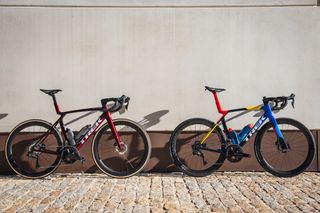
Interestingly, the overall offering has shrunk from eight sizes to six.
“We had a lot of sizes that had a lot of overlap,” Roessingh explains. “Many riders could actually ride two different sizes and that created some confusion of just what frame size to ride, as there were some that were like unbelievably close to each other.” In some cases as little as a 4mm difference in stack height.
The fewer sizes are billed as reducing confusion and consolidating the design of each size. The cynic in me naturally assumed that there was perhaps some manufacturing saving at work there, but Roessingh later walked me through some of the logistics of manufacturing on the scale needed for the Madone. Essentially, reducing eight moulds to six may offer substantial savings for a small frame manufacturer, but when selling thousands of frames per year the turnaround of worn moulds means fewer mould sizes doesn’t necessarily mean fewer moulds.
First ride impressions

Trek’s global launch took place near Cebreros in a mountainous corner of the Castile and León region in Spain. Our riding took us directly into the mountains and into open windy plains.
I was riding the second-tier (Ultegra Di2-equipped) SLR 7, though it was identical to the top-spec SLR 9 as far as the frame design and material. No surprise, then, that there was an immediate sense of speed, power transfer and sharpness riding the Madone.
The previous aero-focussed Madone always excelled in comfort, however, its bulky tubes ultimately gave it the sensation of driving a beefy sports car, while the new SLR not only felt palpably lighter but seemed so much closer to the Emonda in general ride quality. This has the sharp turn of speed and lively handling of a lightweight climber while promising the same speed as an all-out aero machine.
When it comes to all-out speed, it’s very hard to quantify that through a pair of initial test rides. Perhaps the best I could say is that it carried speed well on flat terrain, and at times felt simply blisteringly fast, and was truly a beast on the descents.
It has been too long since I’ve been on a long alpine descent, and despite the relatively shallow inclines, I found myself happily edging toward 80kph. The Madone definitely dared me to take more speed into corners, with a rigid handling character and sat extremely steadily at high speed.
While I always rated the IsoSpeed system for its abundant comfort, the slight detachment between the front and back of the bike with the 9 series was a bit of a sacrifice for the resulting ride quality. With the IsoFlow system, I didn’t notice any discomfort or bumps on the rear end that I felt needed to be filtered out, and the reward in weight and connection to the road was palpable.
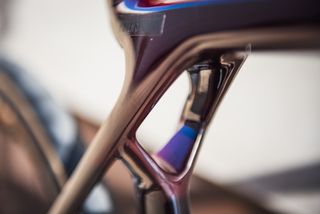
The finishing kit tweaks were probably the most surprising element of my first ride. The squeezed-in handlebar hoods make so much sense. The slight splay in a bar has long been a trend in gravel - offering the wider drops for stability and the narrow for speed. It works very well on the Madone and I was left wondering why we ever bother with hoods that are 42cm apart.
The bottles, despite my scepticism, were easy to handle and never once a hassle to stow or release from the cage.
Early verdict
While I’ve only had a fleeting ride experience with the Madone, my first impression is this is a bike that really shows the maturity of cycling tech at its best. While it’s common to chase wattage gains from minor frame changes, Trek is right to focus on the bike holistically from an aero perspective, where a saving of 3 watts on the bottles could eclipse huge cost and weight gains if those same aerodynamic margins were sought on the frame.
Meanwhile to hit 7kg (in the top-spec SLR 9) with range-topping aerodynamic and stiffness performance is something we didn’t dream of with a disc brake road bike even five years ago. That comes with the benefits of wider tyres and a better experience across climbing, descending and sprinting, alongside great comfort.
With that in mind, the new Madone is very much the everything race bike, but one that could bridge that considerable gap between the needs of the WorldTour’s best and the normal enthusiasts.
I’m excited to spend more time with it, and where this new direction will take one of the most storied bikes in cycling’s history.

Thank you for reading 5 articles in the past 30 days*
Join now for unlimited access
Enjoy your first month for just £1 / $1 / €1
*Read any 5 articles for free in each 30-day period, this automatically resets
After your trial you will be billed £4.99 $7.99 €5.99 per month, cancel anytime. Or sign up for one year for just £49 $79 €59
Try your first month for just £1 / $1 / €1
Peter Stuart has been the editor of Cyclingnews since March 2022, overseeing editorial output across all of Cyclingnews' digital touchpoints.
Before joining Cyclingnews, Peter was the digital editor of Rouleur magazine. Starting life as a freelance feature writer, with bylines in The Times and The Telegraph, he first entered cycling journalism in 2012, joining Cyclist magazine as staff writer. Peter has a background as an international rower, representing Great Britain at Under-23 level and at the Junior Rowing World Championships.
A new Van Rysel bike, unusual tyres, a UCI-illegal helmet, and a million custom paint jobs: Over 80 nerdy tech photos from the Tour de France Grand Départ
New front-only Continental 'Aero 111' tyres spotted at the Tour de France
Lotto Thüringen Ladies Tour: Mischa Bredewold wins stage 5 time trial
Most Popular
Like most sites, this site uses cookies to make it work. By continuing to use the site you accept our cookie policy . You won’t be shown this message again :)
You are using a browser that does not support javascript. Some aspects of this site may not work as intended.
We've got 11,000+ bikes in the comparison database. Find another?
Trek Domane SLR 2020
Prove Humanity: Please click here to start .
Measurements are in millimeters and degrees.
- Bike name and year
- Geometry table
- Add an image
Problem? Flag for Review or
If you like the site, can we ask a favour?
Click now, buy soon, and we'll get a few pennies.
Chain Reaction Cycles - Wiggle - Rose
Thank you! Bob & Dave
Also! Search by Stack and Reach
You can now search the database by numbers .
Find bikes that match your geometry criteria.

- Rider Notes
2022 Trek Domane SLR 7

A carbon frame endurance bike with high-end components and hydraulic disc brakes.
Manufacturer Price
Domane SLR 7 Gen 3
In Stock: 56cm
For This Bike
View more similar bikes →
Based on frame geometry and build specs.
A bike with lower gearing will be easier to ride up steep hills, while a higher top end means it will pedal faster down hills.
Domane SLR 7
Similar Bikes
(descending)
Add custom gearing
Based on build material and quality level of the frame, fork, wheelset, groupset, suspension system, and more.
152cm – 159cm
157cm – 164cm
162cm – 169cm
167cm – 175cm
173cm – 181cm
179cm – 186cm
184cm – 191cm
189cm – 195cm
- 183cm, size 56cm, Just right

Now on its fourth iteration, the Trek Domane AL is packed with updates, a lighter frame, and room for larger tires.
Read Review

Sept 2023 · Calvin Zajac
Can the Trek Domane SLR 7 AXS Gen 4 prove to be the ultimate all-road bike and adventure buddy in our 2023 all-road group test?
Coherent and versatile concept
Very comfortable thanks to the inconspicuously integrated IsoSpeed system
Timeless look that you won’t get tired of looking at
Internally routed cables rattle loudly

Apr 2023 · Suvi Loponen
We take a look at the details of the bike that Trek-Segafredo raced through the Hell of the North
Feb 2023 · James Huang
Trek’s latest iteration of its Domane all-roader packs more performance than ever, but there are also some big missteps that give me pause.
Superb rear-end ride quality, stiff and efficient-feeling under power, excellent handling, sleek aesthetics, competitively weight.
Ride quality still a little imbalanced, creaky IsoSpeed/seatpost area, exposed headset bearing, internal housing rub, disappointing tires.

Jan 2023 · Josh Croxton
Fewer Isospeeds means it's a little less comfortable, but the new Domane SLR 9 is fast, fun, and ready for an adventure
Easy to use storage compartment with neat & organising tool wrap
Simplified Isospeed vibration damping
38mm tyre clearance
Power meter included
Neat, low-maintenance integrated cockpit
Oh boy is it pricey
I would hope for top-spec tyres at this price

Oct 2022 · James Spender
The Domane is a tremendously smooth bike thanks to Trek’s IsoSpeed rear damping system and high volume, 32mm tubeless tyres
Over-engineered

Sept 2022 · Warren Rossiter
The latest Domane is true to the original racer, yet massively versatile
Beautifully balanced handling
Smooth-rolling
Well equipped
Price compared to its rivals
Should have the range-topping tyres as standard
Sept 2022 · William Tracy
Trek has simplified its endurance frame and put it on a diet for a more enjoyable ride.

Last updated 26 July Not listed for 337 days

IMAGES
VIDEO
COMMENTS
Domane SLR 7 Disc pairs the best endurance road bike frame with a full Shimano Ultegra Di2 electronic drivetrain for precision shifting. This is an ultralight endurance road bike with high-end parts made for a high-performance fast ride, like an ultralight OCLV Carbon frame with sleek internal storage, Front and Adjustable Rear IsoSpeed, carbon ...
Domane+ SLR 7. 15 Reviews / Write a Review. $9,499.99. Model 5274198. Retailer prices may vary depending on location and delivery method. The final price will be shown in your cart. Domane+ SLR 7 is a category-redefining carbon e-road bike built with intensely light 800 Series OCLV Carbon. It hides a compact and refined motor to elevate your ...
7 Reviews / Write a Review. $8,499.99 $8,549.99. Model 5295955. Retailer prices may vary depending on location and delivery method. The final price will be shown in your cart. Domane SLR 7 is an ultralight carbon endurance road bike with high-end parts made for a fast, high-performance ride. You get our highest level OCLV Carbon frame with rear ...
Based on frame geometry and build specs. Rider Position. relaxed aggressive. Terrain. smooth rugged. Domane SLR 7. Other Endurance bikes. ... The headline figures for the new Trek Domane SLR are impressive — Trek claims the bike is up to 27 per cent more compliant than the previous flagship Domane, "one minute per hour faster" than the ...
The Trek Domane SLR 7 AXS Gen 4 in review - Head-to-head in our all-road group test. Sep 2023 · Calvin Zajac. ... Geometry. Specs. Build. Frame: 700 Series OCLV Carbon, front IsoSpeed, adjustable rear IsoSpeed, internal storage, tapered head tube, internal cable routing, 3S chain keeper, DuoTrap S compatible, fender mounts, flat mount disc ...
2021 Trek. Domane SLR 7. A carbon frame endurance bike with high-end components and hydraulic disc brakes. ... Huge tyre clearance, unique geometry is great for the purpose, quite comfortable ride quality, easy to service and upgrade, rides lighter than it feels to pick up, Shimano Tiagra just works, rim width, quality thru-axles. ...
Customize your own high-end road bike with Trek's Project One and enjoy the smooth and stable ride of the Domane SLR 7.
Through Trek's Project One customization program, you can order a lower stack and longer-reach geometry that Trek calls H1.5. The Domane Family. ... the Domane SLR 7 weighed 18.9 pounds (54cm ...
Domane SLR. 2021. Flag for Review. Trek Domane SLR 2021. Prove Humanity: Please click here to start. You should not have to do this more than once. If you continue to see this message, please email hello@[the site's address] for support. c . Geometry. Loading... 47 cm 50 cm 52 cm 54 cm 56 cm 58 cm 60 cm
Domane SLR 7 Review. A quick, high-performance ride is possible with the Domane SLR 7, an ultralight endurance road bike with premium components. ... Geometry and Comfort. ... What does trek Domane SLR 7 weigh? Domane SLR 7 weighs around (size 56) - 8.40 kg / 18.52 lbs (with TLR sealant, no tubes). This bike has a maximum total weight limit ...
Both geometries will be offered through Trek's Project One custom program (albeit only with rim brakes to start). Prices and key component specs are as follows: Domane SLR 9 eTap (US$11,000 / AU$12,999 / £7,600) OCLV 600-Series frame and fork. SRAM Red eTap groupset.
Weighing within a whisker of the top-tier SLR 9 eTap, the SLR 7 is likely to be the best-selling option in the SLR range. Trek claims a complete bike without pedals to be 7.89 kg (17.41 lbs). The Domane SLR7 swaps the SRAM Force for Shimano Ultegra 12-speed. It's priced at US$8,550 / €10,000 / £9,000 / AU$12,300.
Model 5262276. Retailer prices may vary depending on location and delivery method. The final price will be shown in your cart. Domane SLR 7 is an ultralight endurance road bike with high-end parts made for a fast, high-performance ride. You get an OCLV Carbon frame with Front and Adjustable Rear IsoSpeed and sleek internal storage, an all-new ...
The Domane+ SLR frame is built to Trek's standard H2 endurance geometry with a taller head tube and longer chain stays for greater comfort and stability. The build also features the same D-shaped seat post, IsoSpeed decoupling system and integrated cable routing as the standard Domane SLR.
Domane+ SLR 7 is a category-redefining carbon e-road bike that doesn't look, fit, or feel like a standard e-bike. It's built on an 800 Series OCLV Carbon frame that hides a compact and refined motor to elevate your ride with natural-feeling assist. The motor quietly blends in with the elements, all but disappearing under you on peaceful solo ...
Hit compare to see this Trek side-by-side with your bike. Like most sites, this site uses cookies to make it work. By continuing to ... Trek Domane 2019. Prove Humanity: Please ... to do this more than once. If you continue to see this message, please email hello@[the site's address] for support. c . Geometry. Loading... 44 cm 47 cm 50 cm 52 cm ...
The Trek Domane SLR 7 AXS Gen 4 in review - Head-to-head in our all-road group test. ... Geometry. Specs. Build. Frame: 500 Series OCLV Carbon, front & rear IsoSpeed, internal storage, tapered head tube, internal cable routing, 3S chain keeper, DuoTrap S compatible, fender mounts, flat mount disc, 142x12mm thru axle ...
Domane SLR. 2018. Flag for Review. Trek Domane SLR 2018. Prove Humanity: Please click here to start. You should not have to do this more than once. If you continue to see this message, please email hello@[the site's address] for support. c . Geometry. Loading... 50 cm 52 cm 54 cm 56 cm 58 cm 60 cm 62 cm
Trek Domane SLR 7 P1 review. Sep 2022 · Warren Rossiter. ... Huge tyre clearance, unique geometry is great for the purpose, quite comfortable ride quality, easy to service and upgrade, rides lighter than it feels to pick up, Shimano Tiagra just works, rim width, quality thru-axles. ... 44, 47, Domane SLR carbon, tapered carbon steerer ...
Domane SLR 7 Disc pairs the best endurance road bike frame with a full Shimano Ultegra Di2 electronic drivetrain for precision shifting. This is an ultra-light endurance road bike with high-end parts made for a high-performance fast ride, like an ultra-light OCLV Carbon frame with sleek internal storage, Front and Adjustable Rear IsoSpeed ...
The new Trek Madone SLR 7 side-on (Image credit: Future/ Peter Stuart) The top tier SLR 9 hits 7kgs matching the weight of the Emonda which has just departed Trek's range (Image credit: Future ...
Trek Domane SLR 7 Disc. May 2017 · William Tracy. Trek's Domane crushes cobbles, sure. But on smooth blacktop it's just as capable. Read Review. Show More Reviews. Geometry. Specs. Build. Frame: 500 Series OCLV Carbon, Front & Rear IsoSpeed, E2 tapered head tube, BB90, direct mount brakes, Power Transfer Construction, hidden fender mounts ...
Domane SLR. 2020. Flag for Review Add an image. Trek Domane SLR 2020. Prove Humanity: Please click here to start. You should not have to do this more than once. If you continue to see this message, please email hello@[the site's address] for support. c . Geometry. Loading... 44 47 50 52 54 56 58 60 62
The Trek Domane SLR 7 AXS Gen 4 in review - Head-to-head in our all-road group test. Sept 2023 · Calvin Zajac. ... Geometry. Specs. Build. Frame: 700 Series OCLV Carbon, front IsoSpeed, adjustable rear IsoSpeed, internal storage, tapered head tube, internal cable routing, 3S chain keeper, DuoTrap S compatible, fender mounts, flat mount disc ...